|
(11) | EP 3 438 092 B1 |
| (12) | EUROPEAN PATENT SPECIFICATION |
|
|
| (54) |
METHOD FOR PREPARING COMPOUND AND METHOD FOR PREPARING POLYMER EMPLOYING THE SAME VERFAHREN ZUR HERSTELLUNG EINER VERBINDUNG UND VERFAHREN ZUR HERSTELLUNG EINES POLYMERS DAMIT PROCÉDÉ DE PRÉPARATION D'UN COMPOSÉ ET PROCÉDÉ DE PRÉPARATION DE POLYMÈRE L'UTILISANT |
|
|
|||||||||||||||||||||||||||||||
| Note: Within nine months from the publication of the mention of the grant of the European patent, any person may give notice to the European Patent Office of opposition to the European patent granted. Notice of opposition shall be filed in a written reasoned statement. It shall not be deemed to have been filed until the opposition fee has been paid. (Art. 99(1) European Patent Convention). |
TECHNICAL FIELD
[0001] The technical field relates to a method for preparing a compound and a method for preparing a polymer.
BACKGROUND
[0002] Polyarylene sulfide (PAS) (or polythioether sulfone (PTES)) is a material with good physical characteristics such as thermal resistance, chemical resistance, flame resistance, non-toxicity, and electrical insulation characteristics. Thus, polyarylene sulfide (PAS) (or polythioether sulfone (PTES)) can be used in computer accessories and auto accessories; as a coating for parts that come into contact with corrosive chemicals; and as industrial fibers having chemical resistance.
[0003] However, conventional methods for preparing polyarylene sulfide (PAS), polythioether sulfone (PTES), or monomers thereof are halogen-containing processes that, in principle, results in a low yield and produces unrecyclable halogen-containing byproducts that can cause environmental pollution.
[0004] Bernard Miller et al., Reactions of diaryl disulfides with active, nonucleophilic alkylating agents, Journal of Organic Chemistry, vol. 36, no.11, 1 June 1971, pages 1513-1519, describes a reaction of diphenyl sulfide with triethyloxonium fluoroborate or diethoxycarbonium fluoroborate to give diethylphenlysulfonium fluoroborate and S-ethylsulfonium salts of ethyl p-thiophenoxyphenyl sulfide and of a product assigned the structure of ethyl p-(p-thiophenoxyphenyl)thiophenoxyphenyl sulfide.
[0005] Pietro Cogolli et al., Nucleophilic aromatic substitution reactions of unactivated aryl halides with thiolate ions in hexamethylphosphoramide, The Journal of Organic Chemistry, vol. 44, no. 15, 1 July 1979, pages 2642-2646, describes a method for the synthesis of aryl thioethers via nucleophilic displacement of unactivated aryl halides by the sodium salts of thiols in hexamethylphosphoramide (HMPA). Further, the effect of substituents was measured.
[0006] Eishun Tsuchida et al., Polymerization of Diphenyl Disulfide by the S-S Bond Cleavage with a Lewis Acid: A Novel Preparation Route to Poly(-phenylene sulfide), Macromolecules, Am. Chem. Soc., US, vol. 23, no. 8, 16 April 1990, pages 2101-2106, describes the manufacturing of Poly(-phenylene sulfide) (PPS) by a cationic and oxidative polymerization. Diphenyl disulfide is allowed to react with a Lewis acid such as antimony pentachloride at room temperature and is polymerized to PPS.
[0007] Gabler R. et al., Neue Polyphenylsulfone Reaktionen an festen Polymeren, Chimia International Journal for Chemistry, vol. 28, no. 9, 1 September 1974, pages 567-575, describes a method by which aromatic polythioethers containing sulfone groups regularly distributed along the polymer chain are oxidized in solid suspensions quantitatively to polyarylenesulfones of the general structure Ar-SO2-Ar-SO2-Ar-SO2-, Ar being identical or different nuclei such as benzene, naphthalene or diphenyl.
[0008] Ding Y et al., Preparation of Poly(thioarylenes)s from Cyclic Disulfide Oligomers, Macromolecules, Am. Chem. Soc., US, vol 30, no. 8, 5 May 1997, pages 2527-2531, describes that a series of Poly(thioarylene)s was prepared from cyclic disulfide oligomers and diiodo or dibromo aromatic compounds in diphenyl ether solution at 270 °C.
[0009] EP 3 190 139 A1 describes a method for preparing an aromatic sulfide or a salt thereof. It is described that due to the use of sulfoxide as a vulcanizing agent and the use of sulfonic anhydride for activating the sulfoxide, the method for preparing aromatic sulfide or a salt thereof of the disclosure can be performed without thiophenol serving as a reactant.
[0010] EP 3 190 140 A1 describes a method for forming a polymer, and in particular to a method for preparing a sulfonium salt polymer or polyarylene sulfide (PAS).
[0011] EP 3 190 141 A1 describes a polymer, and in particular a polyarylene sulfide (PAS) or a salt thereof, wherein the main chain of the polymer of the disclosure consists of different aryl groups alternately arranged.
[0012] EP 3 190 142 A1 describes methods of preparing a PAS monomer without a halogen. More specifically, in the disclosed embodiments, a selective oxidation process in producing the PAS monomer prevents the formation of byproducts of sulfones and sulfoxides due to different oxidation states.
[0013] EP 3 190 143 A1 describes a method for preparing a polyarylene sulfide including reacting a methyl 4-(arylthio)aryl sulfoxide compound with sulfuric acid, methanesulfonic acid, benzenesulfonic acid, p -toluenesulfonic acid or trifluoromethanesulfonic acid to obtain a polysulfonium intermediate; and demethylating the polysulfonium intermediate to obtain a polyarylene sulfide, wherein the polysulfonium intermediate is demethylated with aqueous HCl, HBr, or HI
SUMMARY
[0014] According to embodiments of the disclosure, the disclosure provides a method for preparing a compound. The method includes the following steps. A compound having a structure represented by Formula (I) is reacted with a compound having a structure represented by Formula (III) in the presence of a compound having a structure represented by Formula (II), obtaining a compound having a structure represented by Formula (IV)
, wherein Ar1 is substituted or unsubstituted aryl group; X is -O-, -S-, or -NH-; R1 is independently hydrogen or C1-6 alkyl group; R2 is hydroxyl group, C1-6 alkyl group, phenyl group, or tolyl group; and R3 is independently C1-6 alkyl group, C5-8 cycloalkyl group, or C2-6 alkoxyalkyl group.
[0015] According to embodiments of the disclosure, the disclosure also provides a method for preparing a polymer. The method includes the following steps. A compound having a structure represented by Formula (I) is reacted with a compound having a structure represented by Formula (III) in the presence of a compound having a structure represented by Formula (II), obtaining a compound having a structure represented by Formula (IV). The compound having the structure represented by Formula (IV) is reacted with a compound (A), obtaining a compound having the structure represented by Formula (V). The compound (A) is nitric acid, sulfuric acid, acetic acid, hydrogen peroxide, or a combination thereof. The compound having the structure represented by Formula (V) is reacted with a compound having a structure represented by Formula (VI), obtaining a polymer having a repeat unit represented by Formula (VII)
, wherein Ar1 is substituted or unsubstituted aryl group; X is -O-, -S-, or -NH-; R1 is independently hydrogen or C1-6 alkyl group; R2 is hydroxyl group, C1-6 alkyl group, phenyl group, or tolyl group; R3 is independently C1-6 alkyl group, C5-8 cycloalkyl group, or C2-6 alkoxyalkyl group; R5 is hydroxyl group, C1-6 alkyl group, phenyl group, or tolyl group; and Ar2 is substituted or unsubstituted aryl diradical.
[0016] A detailed description is given in the following embodiments with reference to the accompanying drawings.
DETAILED DESCRIPTION
[0017] The disclosure provides a method for preparing a compound, wherein the starting materials or catalysts of the method for preparing a compound are halogen-free compounds. Thus, no halogen-containing side product is formed. In addition, there is no halogen-containing compound remained in the obtained result. The method for preparing a compound of the disclosure does not include an additional step for removing a halogen-containing side product or residual halogen-containing compound, thereby reducing preparation cost and increasing product yield. Thus, a halogen-free monomer, which can be used in a subsequent polymerization, is obtained.
[0018] Furthermore, the disclosure also provides a method for preparing a polymer (such as polyether sulfone (PES) or polythioether sulfone (PTES). The starting materials of the method for preparing the monomer of the polymer and the method for preparing a polymer are halogen-free compounds. Thus, no halogen-containing side product is formed. In addition, there is no halogen-containing compound remained in the obtained result. The method for preparing a polymer of the disclosure does not include an additional step for removing a halogen-containing side product or residual halogen-containing compound, thereby reducing preparation cost and increasing product yield. Thus, a halogen-free polymer is obtained. Furthermore, the method for preparing a polymer of the disclosure includes subjecting a monomer to an electrophilic polymerization and then performing an oxidation after polymerization. Therefore, the obtained polymer has an increased molecular weight and a reduced polydispersity index (PDI).
[0019] According to embodiments of the disclosure, the disclosure provides a method for preparing a compound, wherein the compound can serve as a monomer for a subsequent polymerization (such as polyether sulfone (PES) polymerization or polythioether sulfone (PTES) polymerization). The method for preparing a compound includes: reacting a compound having a structure represented by Formula (I) with a compound having a structure represented by Formula (III) in the presence of a compound having a structure represented by Formula (II), obtaining a compound having a structure represented by Formula (IV)
, wherein Ar1 can be substituted or unsubstituted aryl group; X can be -O-, -S-, or -NH-; R1 can be independently hydrogen or C1-6 alkyl group; R2 can be hydroxyl group, C1-6 alkyl group, phenyl group, or tolyl group; and R3 can be independently C1-6 alkyl group, C5-8 cycloalkyl group, or C2-6 alkoxyalkyl group. Herein, the substituted aryl group of the disclosure means that at least one hydrogen atom bonded to carbon atoms of the aryl group can be replaced with C1-6 alkyl group.
[0020] According to embodiments of the disclosure, wherein Ar1 can be substituted or unsubstituted phenyl group, biphenyl group, naphthyl group, thienyl group, indolyl group, phenanthrenyl group, indenyl group, anthracenyl group, or fluorenylene group. In particular, the substituted phenyl group, substituted biphenyl group, substituted naphthyl group, substituted thienyl group, substituted indolyl group, substituted phenanthrenyl group, substituted indenyl group, substituted anthracenyl group, or substituted fluorenylene group means that at least one hydrogen atom bonded to carbon atoms of the aforementioned group can be replaced with C1-6 alkyl group.
[0021] According to embodiments of the disclosure, C1-6 alkyl group can be linear or branched alkyl group, such as methyl group, ethyl group, propyl group, isopropyl group, n-butyl group, t-butyl group, sec-butyl group, isobutyl group, pentyl group, or hexyl group.
[0022] According to embodiments of the disclosure, R1 can be independently hydrogen, methyl group, ethyl group, propyl group, isopropyl group, n-butyl group, t-butyl group, sec-butyl group, isobutyl group, pentyl group, or hexyl group.
[0023] According to embodiments of the disclosure, R2 can be hydroxyl group, methyl group, ethyl group, propyl group, isopropyl group, n-butyl group, t-butyl group, sec-butyl group, isobutyl group, pentyl group, hexyl group, phenyl group, or tolyl group.
[0024] According to embodiments of the disclosure, R3 can be independently methyl group, ethyl group, propyl group, isopropyl group, n-butyl group, t-butyl group, sec-butyl group, isobutyl group, pentyl group, hexyl group, cyclopentyl group, cyclohexyl group, cycloheptyl group, cyclooctyl group, or
wherein 1≦n≦5, 0≦ m≦4, and 1≦n+m≦5.
[0025] According to embodiments of the disclosure, The compound having the structure of Formula (I) can be
or
wherein R1 has the same definition as above; and R4 can be independently hydrogen or C1-6 alkyl group.
[0026] According to embodiments of the disclosure, R4 can be independently hydrogen, methyl group, ethyl group, propyl group, isopropyl group, n-butyl group, t-butyl group, sec-butyl group, isobutyl group, pentyl group, or hexyl group.
[0027] According to embodiments of the disclosure, the compound having the structure of Formula (II) can be sulfuric acid, methanesulfonic acid, benzenesulfonic acid, p-toluenesulfonic acid, or a combination thereof.
[0028] According to embodiments of the disclosure, the compound having the structure of Formula (III) can be
[0029] According to embodiments of the disclosure, the disclosure provides a method for preparing the compound having the structure of Formula (IV), wherein the compound having the structure of Formula (IV) can be
or
wherein R1, R3, and R4 have the same definition as above.
[0030] According to embodiments of the disclosure, the method for preparing the compound having the structure of Formula (IV) of the disclosure can include dissolving the compound having the structure of Formula (I) and the compound having the structure of Formula (II) in a solvent, obtaining a mixture. Next, the compound having the structure of Formula (III) is added into the mixture to undergo a reaction, obtaining a compound having a structure represented by Formula (IV). The synthesis pathway of the above reaction is as follows:
, wherein Ar1, X, R1, R2, and R3 have the same definition as above. Herein, the solvent can be any solvent (such as halogen-free organic solvent) which can be used to dissolve the compound having the structure of Formula (I) and the compound having the structure of Formula (II). Furthermore, a halogen-containing organic solvent, which is easily removed after the reaction is complete and would not be active in the desired reaction, can also serve as the solvent of the above reaction. According to embodiments of the disclosure, the solvent can be an aprotic solvent. The solvent, for example, can include acetonitrile, linear or cyclic alkane (such as propane, butane, or cyclohexane), haloalkane (dichloromethane, trichloromethane, or dichloroethane). Furthermore, the reaction can be performed in the absence of a solvent.
[0031] According to embodiments of the disclosure, in the method for preparing the compound of the disclosure, the molar ratio of the compound having the structure of Formula (II) to the compound having the structure of Formula (I) can be from about 0.5 to 5; Furthermore, in the method for preparing the compound of the disclosure, The molar ratio of the compound having the structure of Formula (I) to the compound having the structure of Formula (III) can be from about 1 to 20, such as from about 1 to 3, or from about 1 to 10.
[0032] According to some embodiments of the disclosure, the method for preparing the compound of the disclosure, after preparing the compound having the structure of Formula (IV), further includes reacting the compound having the structure represented by Formula (IV) with a compound (A), obtaining a compound having the structure represented by Formula (V)
, wherein the compound (A) can be nitric acid, sulfuric acid, acetic acid, hydrogen peroxide, or a combination thereof; and Ar1, X, and R3 has the same definition as above.
[0033] According to embodiments of the disclosure, the disclosure provides a method for preparing the compound having the structure of Formula (V), wherein the compound having the structure of Formula (V) can be
or
wherein R1, R3, and R4 have the same definition as above.
[0034] According to embodiments of the disclosure, the method for preparing the compound having the structure of Formula (V) of the disclosure can include dissolving the compound having the structure of Formula (I) and the compound having the structure of Formula (II) in a first solvent, obtaining a mixture. Next, the compound having the structure of Formula (III) is added into the mixture to undergo a reaction, obtaining a compound having a structure represented by Formula (IV). Next, the compound having the structure of Formula (IV) is dissolved in a second solvent, and the compound (A) is added to undergo a reaction, obtaining a compound having the structure represented by Formula (V). The synthesis pathway of the above reaction is as follows:
, wherein Ar1, X, R1, R2 and R3 have the same definition as above. Herein, when X is S, the S atom bonded to R3 group can be selectively oxidized in comparison with X since the S atom bonded to R3 group exhibits a relatively low steric hindrance and has a suitable oxidation potential for oxidation.
[0035] According to embodiments of the disclosure, the first solvent can be any solvent which can be used to dissolve the compound having the structure of Formula (I) and the compound having the structure of Formula (II). The second solvent can be any solvent which can be used to dissolve the compound having the structure of Formula (IV). According to embodiments of the disclosure, a halogen-free organic solvent can serve as the first solvent or the second solvent. Furthermore, a halogen-containing organic solvent, which is easily removed after the reaction is complete and would not be active in the desired reaction, can also serve as the solvent of the above reaction. According to embodiments of the disclosure, the first solvent or the second solvent can be an aprotic solvent. The solvent, for example, can include acetonitrile, linear or cyclic alkane (such as propane, butane, or cyclohexane), or haloalkane (dichloromethane, trichloromethane, or dichloroethane). Furthermore, the reaction can be performed in the absence of a solvent. The molar ratio of the compound having the structure of Formula (IV) to the compound (A) can be from about 0.8 to 30.
[0036] According to embodiments of the disclosure, the disclosure provides a method for preparing a polymer. The method for preparing a polymer includes the following steps. First, a compound having a structure represented by Formula (I) is reacted with a compound having a structure represented by Formula (III) in the presence of a compound having a structure represented by Formula (II), obtaining a compound having a structure represented by Formula (IV). Next, the compound having the structure represented by Formula (IV) is reacted with a compound (A), obtaining a compound having the structure represented by Formula (V), wherein the compound (A) is nitric acid, sulfuric acid, acetic acid, hydrogen peroxide, or a combination thereof. Next, the compound having the structure represented by Formula (V) is reacted with a compound having a structure represented by Formula (VI), obtaining a polymer having a repeat unit represented by Formula (VII)
, wherein Ar1, X, R1, R2, and R3 has the same definition as above; R5 is hydroxyl group, C1-6 alkyl group, phenyl group, or tolyl group; and Ar2 is substituted or unsubstituted aryl diradical. The method for preparing a polymer of the disclosure can be used to prepare a polymer having a number average molecular weight greater than or equal to 1,000. It should be noted that the method for preparing a polymer of the disclosure is particularly suitable for preparing a polymer having a great number average molecular weight (such as greater than or equal to 80,000) and a narrow polydispersity index (PDI) (such as less than or equal to 2). According to embodiments of the disclosure, the method for preparing a polymer of the disclosure is particularly suitable for preparing a polymer having a number average molecular weight from 80,000 to 500,000 and a polydispersity index (PDI) from 1 to 2. According to some embodiments of the disclosure, the method for preparing a polymer of the disclosure is particularly suitable for preparing a polymer having a number average molecular weight from 80,000 to 200,000 and polydispersity index (PDI) from 1.4 to 2.
[0037] According to embodiments of the disclosure, R5 can be hydroxyl, methyl group, ethyl group, propyl group, isopropyl group, n-butyl group, t-butyl group, sec-butyl group, isobutyl group, pentyl group, hexyl group, phenyl group, or tolyl group.
[0038] According to embodiments of the disclosure, the substituted aryl diradical of the disclosure means that at least one hydrogen atom bonded to carbon atoms of the aryl diradical can be replaced with C1-6 alkyl group.
[0039] According to embodiments of the disclosure, Ar2 can be substituted or unsubstituted phenylene group, biphenylene group, naphthylene group, thienylene group, indolylene group, phenanthrenylene group, indenylene group, anthracenylene group, or fluorenylene group. In particular, the substituted phenylene group, substituted biphenylene group, substituted naphthylene group, substituted thienylene group, substituted indolylene group, substituted phenanthrenylene group, substituted indenylene group, substituted anthracenylene group, or substituted fluorenylene group means that at least one hydrogen atom bonded to carbon atoms of the aforementioned group can be replaced with C1-6 alkyl group.
[0040] According to embodiments of the disclosure, in the method for preparing the polymer of the disclosure, the molar ratio of the compound having the structure of Formula (II) to the compound having the structure of Formula (I) can be from about 0.5 to 5. Furthermore, in the method for preparing the compound of the disclosure, the molar ratio of the compound having the structure of Formula (I) to the compound having the structure of Formula (III) can be from about 1 to 20, such as from about 1 to 3, or from about 1 to 10. The molar ratio of the compound having the structure of Formula (IV) to the compound (A) (such as nitric acid, sulfuric acid, acetic acid, hydrogen peroxide, or a combination thereof) can be from about 0.8 to 30; and the molar ratio of the compound having the structure of Formula (V) to the compound having the structure of Formula (VI) can be from about 0.8 to 20, such as from about 1.2 to 5. Furthermore, the compound having the structure of Formula (VI) can serve as a reactant for reacting with the compound having the structure of Formula (V), and the excessive compound having the structure of Formula (VI) can also serve as the reaction solvent.
[0041] According to embodiments of the disclosure, the compound having the structure of Formula (VI) can be sulfuric acid, methanesulfonic acid, benzenesulfonic acid, p-toluenesulfonic acid, trifluoromethanesulfonic acid or a combination thereof. Furthermore, according to embodiments of the disclosure, the compound having the structure of Formula (II) and the compound having the structure of Formula (VI) can be the same or different.
[0042] According to embodiments of the disclosure, the method for preparing the polymer of the disclosure can be used to prepare the polymer having a repeat unit represented by Formula (VII). For example, the repeat unit represented by Formula (VII) can be
or
wherein R1, R3, R4, and R5 have the same definition as above.
[0043] According to embodiments of the disclosure, the method for preparing the polymer having a repeat unit represented by Formula (VII) of the disclosure can include dissolving the compound having the structure of Formula (I) and the compound having the structure of Formula (II) in a first solvent, obtaining a mixture. Next, the compound having the structure of Formula (III) is added into the mixture to undergo a reaction, obtaining a compound having a structure represented by Formula (IV). Next, the compound having the structure of Formula (IV) is dissolved in a second solvent, the compound (A) is added to undergo a reaction, obtaining a compound having the structure represented by Formula (V). Next, the compound having the structure represented by Formula (V) is reacted with a compound having a structure represented by Formula (VI), obtaining a polymer having a repeat unit represented by Formula (VII). The synthesis pathway for preparing the above polymer is as follows:
, wherein Ar1, Ar2, X, R1, R2, R3, and R5 have the same definition as above.
[0044] According to embodiments of the disclosure, after preparing the polymer having the repeat unit represented by Formula (VII), the method for preparing the polymer of the disclosure further includes reacting a nucleophile with the polymer having the repeat unit represented by Formula (VII), obtaining a polymer having a repeat unit represented by Formula (VIII)
, wherein Ar2, X, R1, R3, and R5 have the same definition as above. The synthesis pathway of the above method for preparing the polymer having the repeat unit represented by Formula (VIII) is as follows:
, wherein Ar1, Ar2, X, R1, R2, R3 and R5 have the same definition as above.
[0045] According to embodiments of the disclosure, the nucleophile can be substituted or unsubstituted pyridine or derivatives thereof (such as pyridine or 4-methylpyridine), amine (such as triethylamine), halogenated salt (such as potassium chloride), alcohol (such as methanol or ethanol), amide (such as dimethylformamide, dimethylacetamide, or N-methylpyrrolidone), or a combination thereof. The equivalent ratio of the nucleophile to the moiety represented by
of the polymer having the repeat unit represented by Formula (VII) can be from 1 to 10. According to embodiments of the disclosure, the nucleophile and the polymer having the repeat unit represented by Formula (VII) can optionally be dissolved into an organic solvent before undergoing the reaction.
[0046] According to embodiments of the disclosure, when X of the repeat unit represented by Formula (VIII) is -O- or -NH- (i.e. the repeat unit represented by Formula (VIII) is
wherein Ar2, and R1 have the same definition as above), the method for preparing the polymer of the disclosure can further include, after obtaining the polymer having the repeat unit represented by Formula (VIII), reacting the polymer having the repeat unit represented by Formula (VIII) with hydrogen peroxide (H2O2), obtaining a polymer having a repeat unit represented by Formula (X). Alternatively, the polymer having the repeat unit represented by Formula (VIII) can be reacted with hydrogen peroxide in the presence of the compound having a structure represented by Formula (IX), obtaining the polymer having the repeat unit represented by Formula (X)
, wherein X can be -O- or -NH-; R6 is C1-6 alkyl group; and Ar2 and R1 have the same definition as above. The synthesis pathway of the above method for preparing the polymer having the repeat unit represented by Formula (X) is as follows:
, wherein X can be -O- or -NH-; and Ar1, Ar2, R1, R2, R3, R5 and R6 have the same definition as above.
[0047] According to other embodiments of the disclosure, in the method for preparing the polymer having the repeat unit represented by Formula (X) of the disclosure, the polymer having the repeat unit represented by Formula (VIII), the compound having the structure of Formula (IX), and hydrogen peroxide can be dissolved into a solvent before undergoing the reaction. For example, the solvent can be amide-type solvent or sulfoxide-type solvent.
[0048] According to embodiments of the disclosure, R6 can be independently methyl group, ethyl group, propyl group, isopropyl group, n-butyl group, t-butyl group, sec-butyl group, isobutyl group, pentyl group, or hexyl group.
[0049] According to embodiments of the disclosure, when X of the repeat unit represented by Formula (VII) is -S- (i.e. the repeat unit represented by Formula (VII) is
wherein Ar2, R1, R3, and R5 have the same definition as above), the method for preparing the polymer of the disclosure, after obtaining the polymer having the repeat unit represented by Formula (VII), can further include reacting the polymer having the repeat unit represented by Formula (VII) with hydrogen peroxide, obtaining a polymer having a repeat unit represented by Formula (XI). Alternatively, the polymer having the repeat unit represented by Formula (VII) is reacted with hydrogen peroxide in the presence of the compound having the structure of Formula (IX), obtaining the polymer having the repeat unit represented by Formula (XI).
, wherein X can be -S-; and Ar2, R1, R3, R5 and R6 have the same definition as above. The synthesis pathway of the above method for preparing the polymer having the repeat unit represented by Formula (XI) is as follows:
, wherein X can be -S-; and Ar1, Ar2, R1, R2, R3, R5 and R6 have the same definition as above.
[0050] According to other embodiments of the disclosure, in the method for preparing the polymer having a repeat unit represented by Formula (XI) of the disclosure, the polymer having the repeat unit represented by Formula (VII) and hydrogen peroxide can be dissolved into an organic solvent and then the mixture is reacted with the compound having the structure represented by Formula (IX) to undergo the reaction. For example, the solvent can be nitrile-type solvent, amide-type solvent, or sulfoxide-type solvent. Furthermore, the polymer having the repeat unit represented by Formula (VII), the compound having the structure represented by Formula (IX), and hydrogen peroxide can be dissolved into an organic solvent before undergoing the reaction.
[0051] According to embodiments of the disclosure, after preparing the polymer having a repeat unit represented by Formula (XI), the method for preparing the polymer of the disclosure can further include reacting a nucleophile with the polymer having the repeat unit represented by Formula (XI), obtaining a polymer having a repeat unit represented by Formula (XII)
, wherein Ar2, R1, R3, and R5 have the same definition as above. The synthesis pathway of the above method for preparing the polymer having the repeat unit represented by Formula (XII) is as follows:
, wherein X is -S-; and Ar1, Ar2, R1, R2, R3, R5, and R6 have the same definition as above.
[0052] According to embodiments of the disclosure, the nucleophile can be substituted or unsubstituted pyridine or derivatives thereof (such as pyridine or 4-methylpyridine), amine (such as triethylamine), halogenated salt (such as potassium chloride), alcohol (such as methanol or ethanol), amide (such as dimethylformamide, dimethylacetamide, or N-methylpyrrolidone), or a combination thereof. The equivalent ratio of the nucleophile to the moiety represented by
of the polymer having the repeat unit represented by Formula (XI) can be from 1 to 10. According to embodiments of the disclosure, the nucleophile and the polymer having the repeat unit represented by Formula (XI) can optionally be dissolved into an organic solvent before undergoing the reaction.
[0053] Below, exemplary embodiments will be described in detail so as to be easily realized by a person having ordinary knowledge in the art. The inventive concept may be embodied in various forms without being limited to the exemplary embodiments set forth herein. Descriptions of well-known parts are omitted for clarity.
Example 1:
[0054] 5g of diphenyl ether, 11.7g of benzenesulfonic acid, and 50ml of dichloromethane were added into a reaction bottle under nitrogen atmosphere, and then cooled to 15°C. Next, 5.54g of 1,2-dimethyldisulfane was added into the reaction bottle. After reacting at 15°C for 20hr, the result was mixed with 50ml of sodium hydroxide aqueous solution (the weight ratio of sodium hydroxide to water is 1:10). After stirring for 0.5hr, the result was extracted three times using dichloromethane and water as the extraction solvent. Next, an organic phase was separated and dried, obtaining Compound (1). The synthesis pathway of the above reaction was as follows:
[0055] Compound (1) was analyzed by nuclear magnetic resonance (NMR) spectroscopy and the result is as follows: 1H NMR (400MHz, ppm, CDCl3): 2.50 (-CH3, 3H, s), 7.00 (phenyl, 4H, m), 7.14 (phenyl, 1H, t), 7.32-7.41 (phenyl, 4H, m).
Example 2:
[0056] 0.73g of Compound (1), 12ml of nitric acid aqueous solution (with a concentration of 20%), and 4ml of acetonitrile were added into a reaction bottle. After stirring at room temperature for 4hr, 10ml of sodium hydroxide aqueous solution (with a concentration of 3%) was added into the reaction bottle. Next, after the reaction was complete, the result was separated and dried, obtaining Compound (2) (orange powder). The synthesis pathway of the above reaction was as follows:
[0057] Compound (2) was analyzed by nuclear magnetic resonance (NMR) spectroscopy and the result is as follows: 1H NMR (400MHz, ppm, CD3CO): 2.71 (-CH3, 3H, s), 7.10-7.25 (phenyl, 5H, m), 7.44-7.48 (phenyl, 2H, t), 7.70-7.72 (phenyl, 2H, d).
Example 3:
[0058] 0.65g of Compound (2) was added into a reaction bottle. Next, 3ml of methanesulfonic acid (CH3SO3H) was added into the reaction bottle placed in an ice bath. After reacting for 1hr, the reaction bottle was raised to room temperature and then reacted at room temperature for 20hr, obtaining a solution including Polymer (1). Next, the solution including Polymer (1) was added into 100ml of ethyl ether and stirred for 30min. Next, 6ml of 4-methylpyridine was added under nitrogen atmosphere and then the result was stirred at 100°C for 4-6hr. After the reaction was complete, the result was added into 100ml of hydrochloric acid solution (with a concentration of 10%) and then stirred for 10min. After concentrating, Polymer (2) was obtained. The synthesis pathway of the above reaction was as follows:
[0059] Polymer (2) was analyzed by nuclear magnetic resonance (NMR) spectroscopy and the result is as follows: 1H NMR (400MHz, ppm, (CD3)2SO): 7.04 (phenyl, d), 7.36 (phenyl, d).
Example 4:
[0060] 0.2g of Polymer (2), 10ml of acetic acid, 0.9g of hydrogen peroxide solution (with a concentration of 30%) and 2ml of dimethylacetamide (DMAc) were added into a reaction bottle, and the reaction bottle was stirred at 80°C for 6hr. Next, the result was concentrated, obtaining Polymer (3). The synthesis pathway of the above reaction was as follows:
[0061] Polymer (3) was analyzed by nuclear magnetic resonance (NMR) spectroscopy and the result is as follows: 1H NMR (400MHz, ppm, (CD3)2SO): 7.28 (phenyl, d), 7.99 (phenyl, d). Next, Polymer (3) was analyzed by Fourier-transform infrared (FT-IR) spectroscopy, and the result shows that the strong absorption peaks are 1483 cm-1 (characteristic vibration frequency of benzene ring), 1575 cm-1 (characteristic vibration frequency of benzene ring), 1295 cm-1 (asymmetry vibration frequency of S=O), 1318 cm-1 (asymmetry vibration frequency of S=O), and 1145 cm-1 (symmetry vibration frequency of S=O). The properties of Polymer (3) were measured by a differential scanning calorimetry (DSC), and the result shows Polymer (3) has a glass transition temperature (Tg) of about 210 °C. Polymer (3) was analyzed by gel permeation chromatography (GPC), and the results show Polymer (3) has a weight average molecular weight (Mw) of about 128,287, a number average molecular weight (Mn) of about 85,435, and a polydispersity index (PDI) of about 1.5.
Example 5:
[0062] 5.58g of diphenyl sulfide and 5.64g of 1,2-dimethyldisulfane were added into a reaction bottle, and then 50ml of dichloromethane as solvent was added into the reaction bottle. Next, 11.7g of benzenesulfonic acid was added into the reaction bottle. After reacting at 15°C for 44hr, the result was extracted three times using 150ml of n-hexane dichloromethane and water as the extraction solvent. Next, an organic phase was separated, dried, and purified by column chromatography, obtaining Compound (3). The synthesis pathway of the above reaction was as follows:
[0063] Compound (3) was analyzed by nuclear magnetic resonance (NMR) spectroscopy and the result is as follows: 1H NMR (400MHz, ppm, CDCl3): 2.50 (-CH3, 3H, s), 7.21-7.34 (phenyl, 9H, m).
Example 6:
[0064] 5.07g of Compound (3) was added into a reaction bottle, and then 20ml of acetonitrile as solvent was added into the reaction bottle. Next, 60ml of nitric acid aqueous solution (with a concentration of 20%) was added into the reaction bottle. After reacting at room temperature for 4hr, 12g of sodium hydroxide was added into the reaction bottle to neutralize the solution. The result was extracted three times using 150ml of dichloromethane as the extraction solvent. Next, an organic phase was separated and dried, obtaining Compound (4). The synthesis pathway of the above reaction was as follows:
[0065] Compound (4) was analyzed by nuclear magnetic resonance (NMR) spectroscopy and the result is as follows: 1H NMR (400MHz, ppm, CDCl3): 2.73 (-CH3, 3H, s), 7.34-7.49 (phenyl, 9H, m).
Example 7:
[0066] 3g of Compound (4) was added into a reaction bottle, and 10ml of methanesulfonic acid was added into the reaction bottle at 15°C. After reacting for 20hr, 50ml of water was added into the reaction bottle to cause a precipitation. The precipitate was separated and dried, obtaining a white solid. The white solid was dissolved in a solvent including 46ml of chloroform and 46ml of trifluoroacetic acid. Next, 4.14g of hydrogen peroxide aqueous solution (with a concentration of 30%) was added and then the result was reacted at 60°C for 5hr. After the reaction was complete, the result was mixed with a water to cause a precipitation. The precipitate was separated and dried, obtaining Polymer (4). The synthesis pathway of the above reaction was as follows:
[0067] Polymer (4) was analyzed by nuclear magnetic resonance (NMR) spectroscopy and the result is as follows: 1H NMR (400MHz, ppm, d6-DMSO): 7.56 (phenyl, 4H, s), 7.93 (phenyl, 4H, s). The properties of Polymer (4) were measured by a differential scanning calorimetry (DSC), and the result shows Polymer (4) has a glass transition temperature (Tg) of about 222°C.
[0068] Accordingly, the disclosure provides a method for preparing a compound, wherein the starting material or catalyst of the method for preparing a compound is a halogen-free compound. Thus, no halogen-containing side product is formed. In addition, there is no halogen-containing compound remained in the obtained result. The method for preparing a compound of the disclosure does not include an additional step for removing a halogen-containing side product or residual halogen-containing compound, thereby reducing preparation cost and increasing product yield. Thus, a halogen-free monomer, which can be used in a subsequent polymerization, is obtained. Furthermore, the disclosure also provides a method for preparing a polymer (such as polyether sulfone (PES) or polythioether sulfone (PTES)). Since the method for preparing a polymer includes subjecting a monomer to an electrophilic polymerization in an acidic environment and then performing an oxidation after polymerization, the obtained polymer exhibits increased molecular weight and relatively low polydispersity index (PDI).
1. A method for preparing a compound, comprising:
reacting a compound having a structure represented by Formula (I) with a compound having a structure represented by Formula (III) in the presence of a compound having a structure represented by Formula (II), obtaining a compound having a structure represented by Formula (IV)
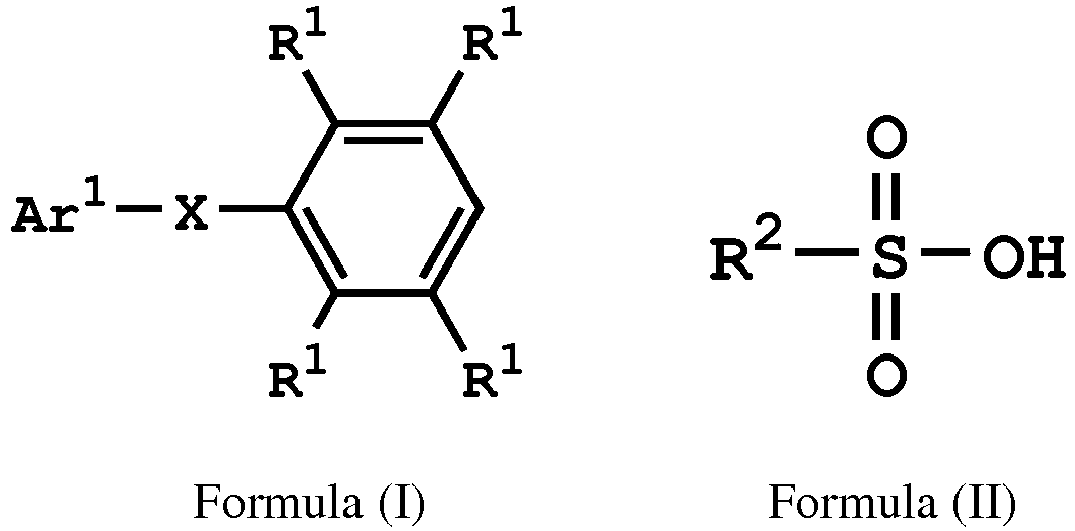

, wherein Ar1 is substituted or unsubstituted aryl group; X is -O-, -S-, or -NH-; R1 is independently hydrogen or C1-6 alkyl group; R2 is hydroxyl group, C1-6 alkyl group, phenyl group, or tolyl group; and R3 is independently C1-6 alkyl group, C5-8 cycloalkyl group, or C2-6 alkoxyalkyl group.
reacting a compound having a structure represented by Formula (I) with a compound having a structure represented by Formula (III) in the presence of a compound having a structure represented by Formula (II), obtaining a compound having a structure represented by Formula (IV)
, wherein Ar1 is substituted or unsubstituted aryl group; X is -O-, -S-, or -NH-; R1 is independently hydrogen or C1-6 alkyl group; R2 is hydroxyl group, C1-6 alkyl group, phenyl group, or tolyl group; and R3 is independently C1-6 alkyl group, C5-8 cycloalkyl group, or C2-6 alkoxyalkyl group.
2. The method as claimed in Claim 1, wherein Ar1 is substituted or unsubstituted phenyl group, biphenyl group, naphthyl group, thienyl
group, indolyl group, phenanthrenyl group, indenyl group, anthracenyl group, or fluorenylene
group, wherein R1 is independently hydrogen, methyl group, ethyl group, propyl group, isopropyl group,
n-butyl group, t-butyl group, sec-butyl group, isobutyl group, pentyl group, or hexyl
group, wherein R3 is independently methyl group, ethyl group, propyl group, isopropyl group, n-butyl
group, t-butyl group, sec-butyl group, isobutyl group, pentyl group, hexyl group,
cyclopentyl group, cyclohexyl group, cycloheptyl group, cyclooctyl group, or

wherein 1≦n≦5, 0≦m≦4, and 1≦n+m ≦5.
wherein 1≦n≦5, 0≦m≦4, and 1≦n+m ≦5.
3. The method as claimed in Claim 1, wherein the compound having the structure of Formula
(I) is






wherein the compound having the structure of Formula (IV) is







or

wherein R1 is independently hydrogen or C1-6 alkyl group; R4 is independently hydrogen or C1-6 alkyl group; and R3 is independently C1-6 alkyl group, C5-8 cycloalkyl group, or C2-6 alkoxyalkyl group, wherein the compound having the structure of Formula (II) is sulfuric acid, methanesulfonic acid, benzenesulfonic acid, p-toluenesulfonic acid, or a combination thereof.
wherein the compound having the structure of Formula (IV) is
or
wherein R1 is independently hydrogen or C1-6 alkyl group; R4 is independently hydrogen or C1-6 alkyl group; and R3 is independently C1-6 alkyl group, C5-8 cycloalkyl group, or C2-6 alkoxyalkyl group, wherein the compound having the structure of Formula (II) is sulfuric acid, methanesulfonic acid, benzenesulfonic acid, p-toluenesulfonic acid, or a combination thereof.
4. The method as claimed in any one of Claims 1-3, further comprising:
reacting the compound having the structure represented by Formula (IV) with a compound (A), obtaining a compound having the structure represented by Formula (V)

, wherein the compound (A) is nitric acid, sulfuric acid, acetic acid, hydrogen peroxide, or a combination thereof; Ar1 is substituted or unsubstituted; X is -O-, -S-, or -NH-; R1 is independently hydrogen or C1-6 alkyl group; and R3 is independently C1-6 alkyl group, C5-8 cycloalkyl group, or C2-6 alkoxyalkyl group.
reacting the compound having the structure represented by Formula (IV) with a compound (A), obtaining a compound having the structure represented by Formula (V)
, wherein the compound (A) is nitric acid, sulfuric acid, acetic acid, hydrogen peroxide, or a combination thereof; Ar1 is substituted or unsubstituted; X is -O-, -S-, or -NH-; R1 is independently hydrogen or C1-6 alkyl group; and R3 is independently C1-6 alkyl group, C5-8 cycloalkyl group, or C2-6 alkoxyalkyl group.
5. The method as claimed in Claim 4, wherein the compound having the structure of Formula
(V) is








or
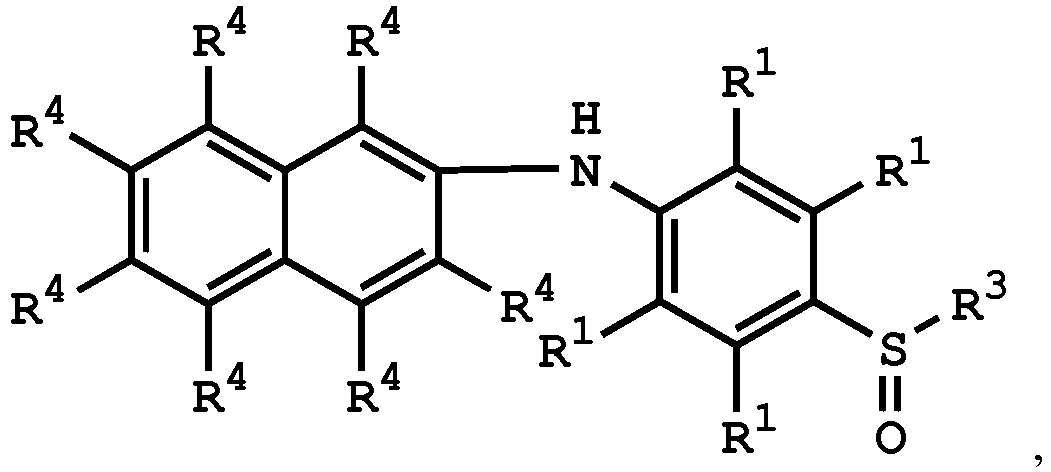
wherein R1 is independently hydrogen or C1-6 alkyl group; R4 is independently hydrogen or C1-6 alkyl group; and R3 is independently C1-6 alkyl group, C5-8 cycloalkyl group, or C2-6 alkoxyalkyl group.
or
wherein R1 is independently hydrogen or C1-6 alkyl group; R4 is independently hydrogen or C1-6 alkyl group; and R3 is independently C1-6 alkyl group, C5-8 cycloalkyl group, or C2-6 alkoxyalkyl group.
6. The method as claimed in any one of Claims 4 and 5, further comprising:
reacting the compound having the structure represented by Formula (V) with a compound having a structure represented by Formula (VI), obtaining a polymer having a repeat unit represented by Formula (VII)
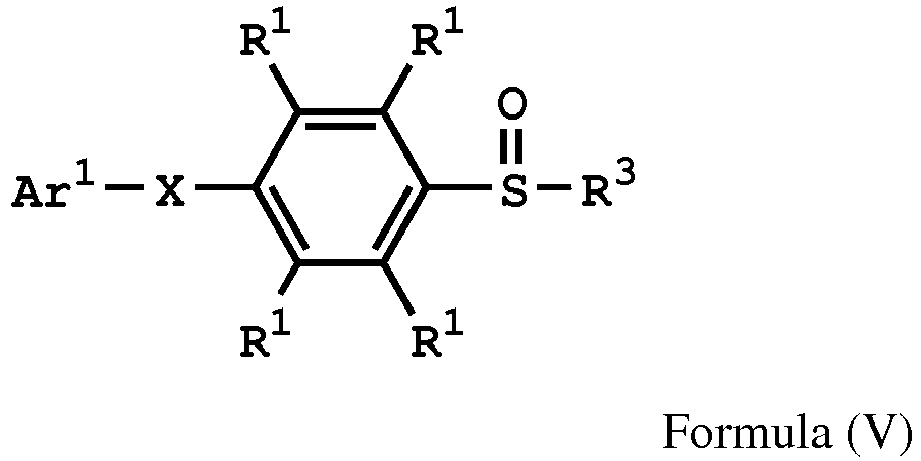

, wherein Ar1 is substituted or unsubstituted aryl group; X is -O-, -S-, or -NH-; R1 is independently hydrogen or C1-6 alkyl group; R3 is independently C1-6 alkyl group, C5-8 cycloalkyl group, or C2-6 alkoxyalkyl group; R5 is hydroxyl group, C1-6 alkyl group, phenyl group, or tolyl group; and Ar2 is substituted or unsubstituted aryl diradical.
reacting the compound having the structure represented by Formula (V) with a compound having a structure represented by Formula (VI), obtaining a polymer having a repeat unit represented by Formula (VII)
, wherein Ar1 is substituted or unsubstituted aryl group; X is -O-, -S-, or -NH-; R1 is independently hydrogen or C1-6 alkyl group; R3 is independently C1-6 alkyl group, C5-8 cycloalkyl group, or C2-6 alkoxyalkyl group; R5 is hydroxyl group, C1-6 alkyl group, phenyl group, or tolyl group; and Ar2 is substituted or unsubstituted aryl diradical.
7. The method as claimed in Claim 6, wherein the compound having the structure of Formula
(VI) is sulfuric acid, methanesulfonic acid, benzenesulfonic acid, p-toluenesulfonic
acid, or a combination thereof.
8. The method as claimed in any one of Claims 6 and 7, wherein Ar2 is substituted or unsubstituted phenylene group, biphenylene group, naphthylene group,
thienylene group, indolylene group, phenanthrenylene group, indenylene group, anthracenylene
group, or fluorenylene group.
9. The method as claimed in any one of Claims 6-8, further comprising:
reacting a nucleophile with the polymer having the repeat unit represented by Formula (VII), obtaining a polymer having a repeat unit represented by Formula (VIII)


, wherein X is -O-, -S-, or -NH-; R1 is independently hydrogen or C1-6 alkyl group; R3 is independently C1-6 alkyl group, C5-8 cycloalkyl group, or C2-6 alkoxyalkyl group; R5 is hydroxyl group, C1-6 alkyl group, phenyl group, or tolyl group; and Ar2 is substituted or unsubstituted aryl diradical.
reacting a nucleophile with the polymer having the repeat unit represented by Formula (VII), obtaining a polymer having a repeat unit represented by Formula (VIII)
, wherein X is -O-, -S-, or -NH-; R1 is independently hydrogen or C1-6 alkyl group; R3 is independently C1-6 alkyl group, C5-8 cycloalkyl group, or C2-6 alkoxyalkyl group; R5 is hydroxyl group, C1-6 alkyl group, phenyl group, or tolyl group; and Ar2 is substituted or unsubstituted aryl diradical.
10. The method as claimed in Claim 9, wherein the nucleophile is pyridine, 4-methylpyridine,
triethylamine, potassium chloride, methanol, ethanol, dimethylformamide, dimethylacetamide,
N-methylpyrrolidone, or a combination thereof.
11. The method as claimed in any one of Claims 9 and 10, when X of the polymer having
the repeat unit represented by Formula (VIII) is -O- or -NH-, further comprising:
reacting the polymer having the repeat unit represented by Formula (VIII) with hydrogen peroxide, obtaining a polymer having a repeat unit represented by Formula (X)
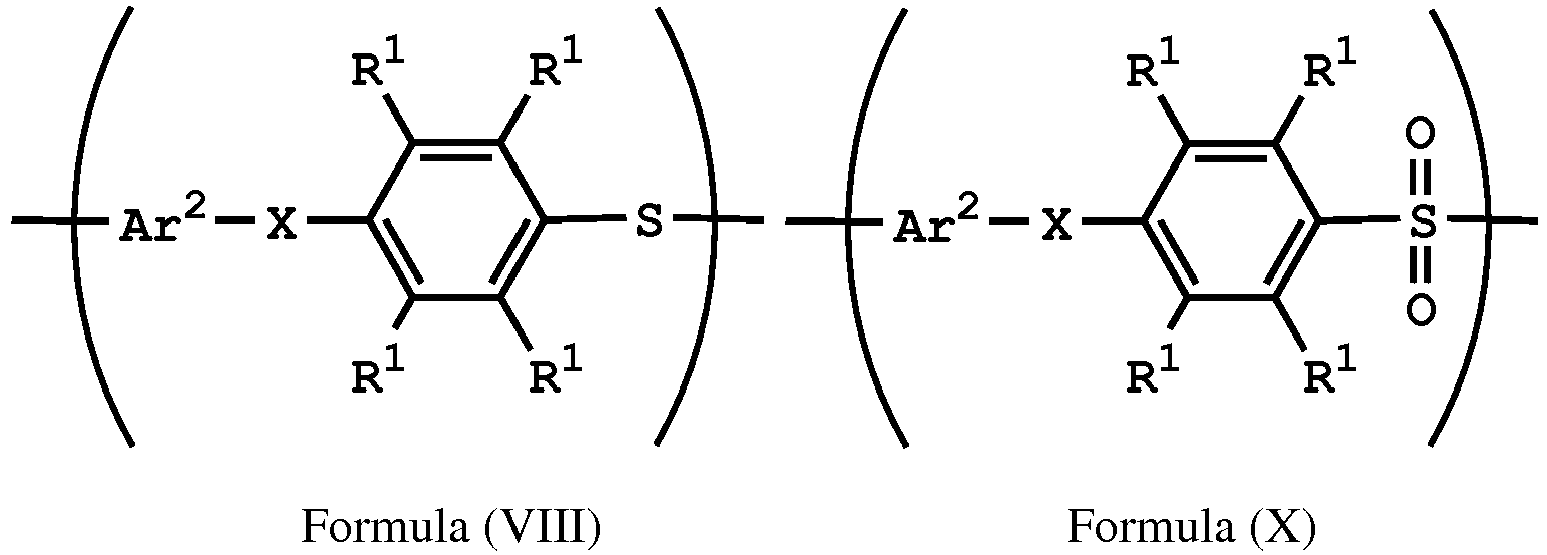
, wherein X is -O- or -NH-; R1 is independently hydrogen or C1-6 alkyl group; and Ar2 is substituted or unsubstituted aryl diradical.
reacting the polymer having the repeat unit represented by Formula (VIII) with hydrogen peroxide, obtaining a polymer having a repeat unit represented by Formula (X)
, wherein X is -O- or -NH-; R1 is independently hydrogen or C1-6 alkyl group; and Ar2 is substituted or unsubstituted aryl diradical.
12. The method as claimed in Claim 11, wherein a polymer having the repeat unit represented
by Formula (VIII) is reacted with hydrogen peroxide in the presence of a compound
having a structure represented by Formula (IX)
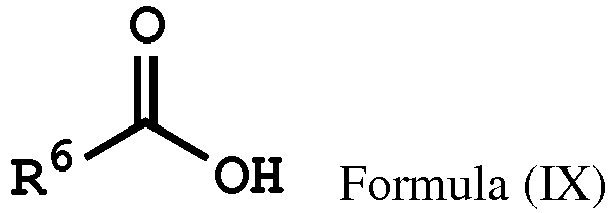
, wherein R6 is C1-6 alkyl group.
, wherein R6 is C1-6 alkyl group.
13. The method as claimed in any one of Claims 6-8, when X of the polymer having the repeat
unit represented by Formula (VII) is -S-, further comprising:
reacting the polymer having the repeat unit represented by Formula (VII) with hydrogen peroxide, obtaining a polymer having a repeat unit represented by Formula (XI)
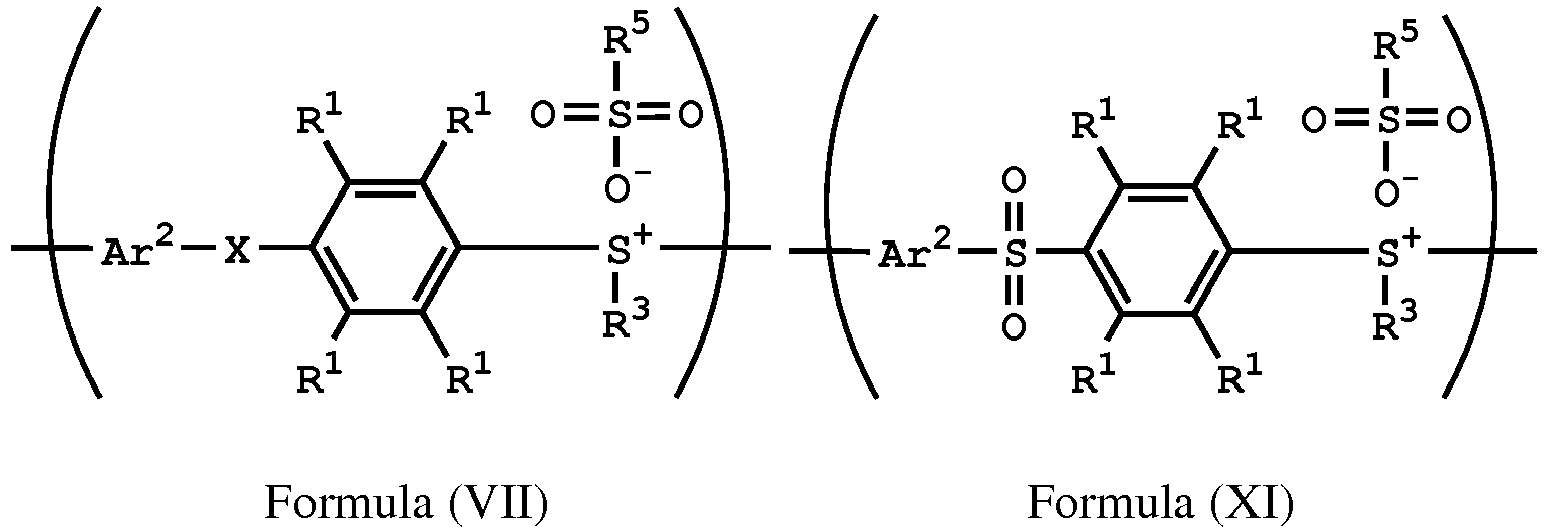
, wherein X is -S-; R1 is independently hydrogen or C1-6 alkyl group; R3 is independently C1-6 alkyl group, C5-8 cycloalkyl group, or C2-6 alkoxyalkyl group; R5 is hydroxyl group, C1-6 alkyl group, phenyl group, or tolyl group; and Ar2 is substituted or unsubstituted aryl diradical.
reacting the polymer having the repeat unit represented by Formula (VII) with hydrogen peroxide, obtaining a polymer having a repeat unit represented by Formula (XI)
, wherein X is -S-; R1 is independently hydrogen or C1-6 alkyl group; R3 is independently C1-6 alkyl group, C5-8 cycloalkyl group, or C2-6 alkoxyalkyl group; R5 is hydroxyl group, C1-6 alkyl group, phenyl group, or tolyl group; and Ar2 is substituted or unsubstituted aryl diradical.
14. The method as claimed in Claim 13, wherein the polymer having the repeat unit represented
by Formula (VII) is reacted with hydrogen peroxide in the presence of a compound having
a structure represented by Formula (IX)
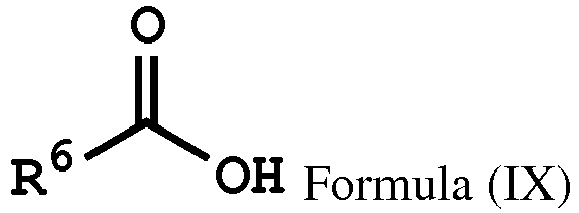
, wherein R6 is C1-6 alkyl group.
, wherein R6 is C1-6 alkyl group.
15. The method as claimed in any one of Claims 13-14, further comprising:
reacting a nucleophile with the polymer having the repeat unit represented by Formula (XI), obtaining a polymer having a repeat unit represented by Formula (XII)
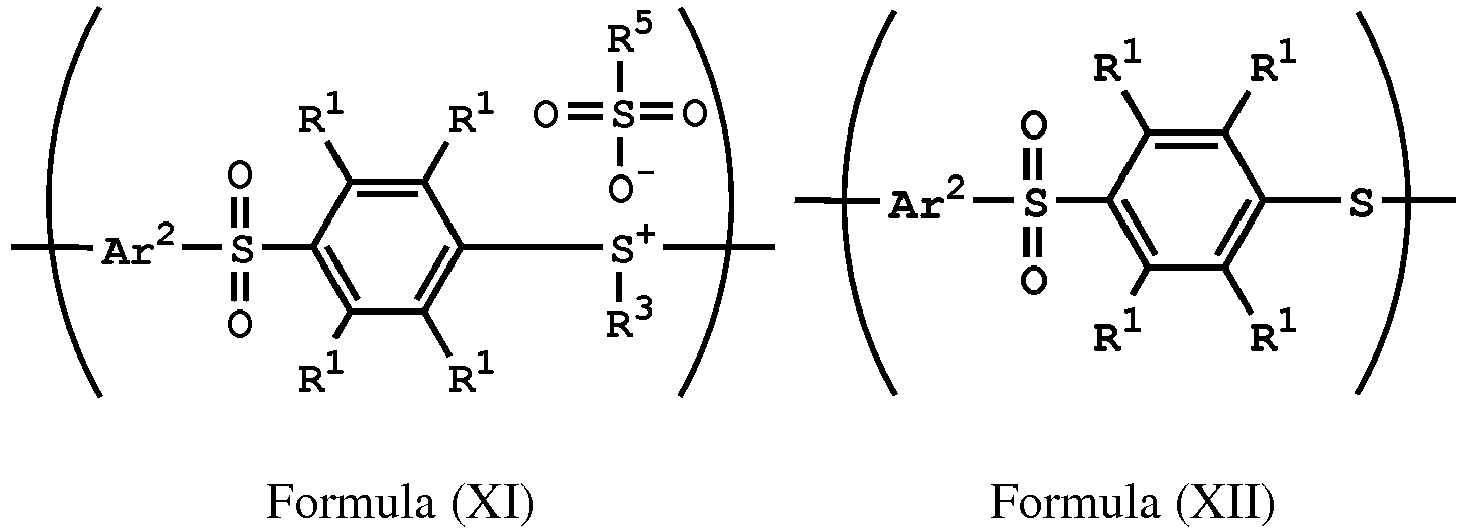
, wherein R1 is independently hydrogen or C1-6 alkyl group; R3 is independently C1-6 alkyl group, C5-8 cycloalkyl group, or C2-6 alkoxyalkyl group; R5 is hydroxyl group, C1-6 alkyl group, phenyl group, or tolyl group; and Ar2 is substituted or unsubstituted aryl diradical, wherein the nucleophile is pyridine, 4-methylpyridine, triethylamine, potassium chloride, methanol, ethanol, dimethylformamide, dimethylacetamide, N-methylpyrrolidone, or a combination thereof.
reacting a nucleophile with the polymer having the repeat unit represented by Formula (XI), obtaining a polymer having a repeat unit represented by Formula (XII)
, wherein R1 is independently hydrogen or C1-6 alkyl group; R3 is independently C1-6 alkyl group, C5-8 cycloalkyl group, or C2-6 alkoxyalkyl group; R5 is hydroxyl group, C1-6 alkyl group, phenyl group, or tolyl group; and Ar2 is substituted or unsubstituted aryl diradical, wherein the nucleophile is pyridine, 4-methylpyridine, triethylamine, potassium chloride, methanol, ethanol, dimethylformamide, dimethylacetamide, N-methylpyrrolidone, or a combination thereof.
1. Verfahren zum Herstellen einer Verbindung, mit den Schritten:
Umsetzen einer Verbindung mit einer durch Formel (I) dargestellten Struktur mit einer Verbindung mit einer durch die Formel (III) dargestellten Struktur in Gegenwart einer Verbindung mit einer durch die Formel (II) dargestellten Struktur und Erhalten einer Verbindung mit einer durch Formel (IV) dargestellten Struktur
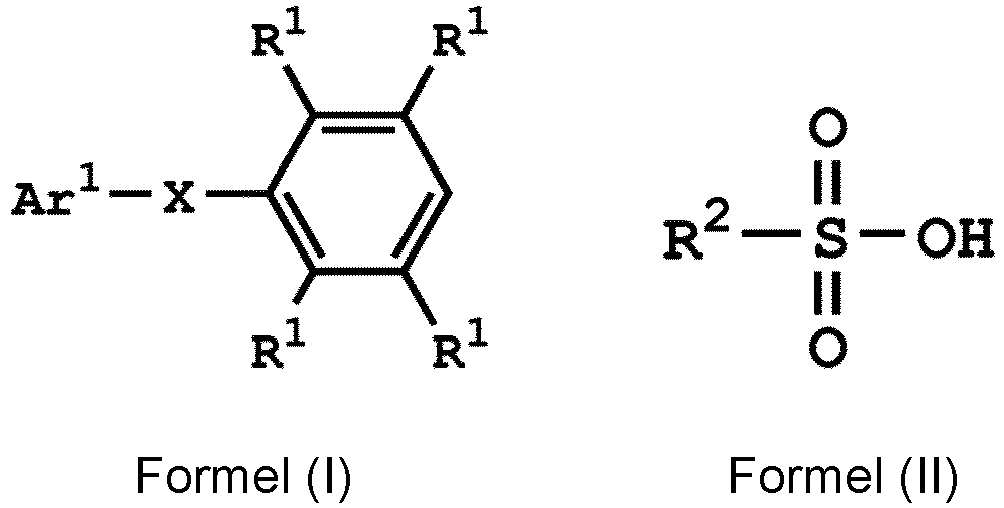
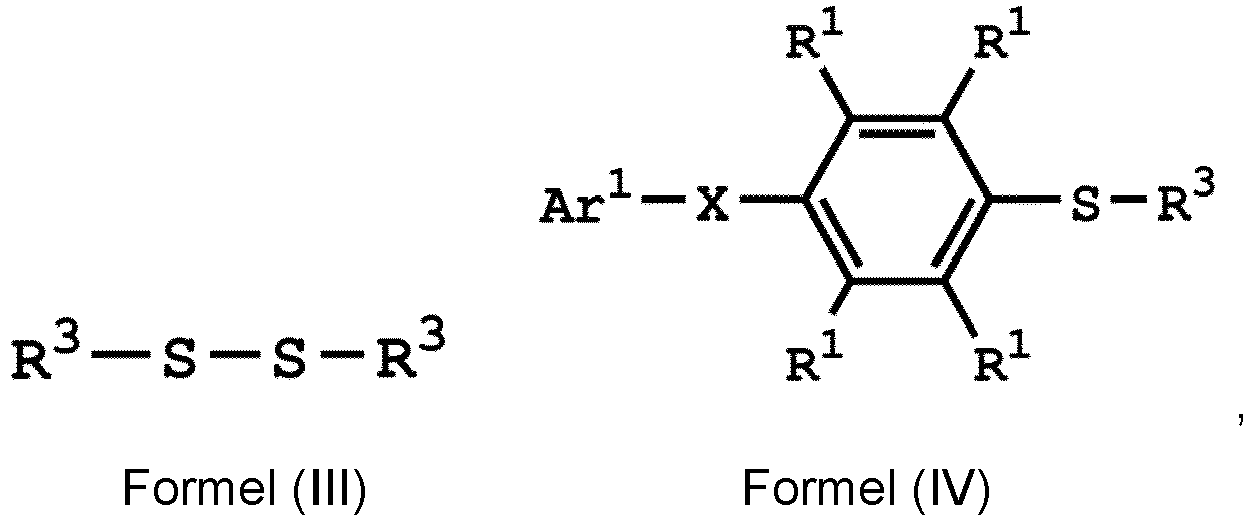
wobei Ar1 eine substituierte oder unsubstituierte Arylgruppe ist; X -O-,-S- oder -NH- ist; R1 unabhängig Wasserstoff oder eine C1-6-Alkylgruppe ist; R2 eine Hydroxylgruppe, eine C1-6-Alkylgruppe, eine Phenylgruppe oder eine Tolylgruppe ist; und R3 unabhängig eine C1-6-Alkylgruppe, eine C5-8-Cycloalkylgruppe oder eine C2-6-Alkoxyalkylgruppe ist.
Umsetzen einer Verbindung mit einer durch Formel (I) dargestellten Struktur mit einer Verbindung mit einer durch die Formel (III) dargestellten Struktur in Gegenwart einer Verbindung mit einer durch die Formel (II) dargestellten Struktur und Erhalten einer Verbindung mit einer durch Formel (IV) dargestellten Struktur
wobei Ar1 eine substituierte oder unsubstituierte Arylgruppe ist; X -O-,-S- oder -NH- ist; R1 unabhängig Wasserstoff oder eine C1-6-Alkylgruppe ist; R2 eine Hydroxylgruppe, eine C1-6-Alkylgruppe, eine Phenylgruppe oder eine Tolylgruppe ist; und R3 unabhängig eine C1-6-Alkylgruppe, eine C5-8-Cycloalkylgruppe oder eine C2-6-Alkoxyalkylgruppe ist.
2. Verfahren nach Anspruch 1, wobei Ar1 eine substituierte oder unsubstituierte Phenylgruppe, Biphenylgruppe, Naphthylgruppe,
Thienylgruppe, Indolylgruppe, Phenanthrenylgruppe, Indenylgruppe, Anthracenylgruppe
oder Fluorenylengruppe ist, wobei R1 unabhängig Wasserstoff, eine Methylgruppe, Ethylgruppe, Propylgruppe, Isopropylgruppe,
n-Butylgruppe, t-Butylgruppe, sec-Butylgruppe, Isobutylgruppe, Pentylgruppe oder Hexylgruppe
ist, wobei R3 unabhängig eine Methylgruppe, Ethylgruppe, Propylgruppe, Isopropylgruppe, n-Butylgruppe,
t-Butylgruppe, sec-Butylgruppe, Isobutylgruppe, Pentylgruppe, Hexylgruppe, Cyclopentylgruppe,
Cyclohexylgruppe, Cycloheptylgruppe, Cyclooctylgruppe oder

ist, wobei 1 ≤ n ≤ 5, 0 ≤ m ≤ 4 und 1 ≤ n + m ≤ 5 ist.
ist, wobei 1 ≤ n ≤ 5, 0 ≤ m ≤ 4 und 1 ≤ n + m ≤ 5 ist.
3. Verfahren nach Anspruch 1, wobei die Verbindung mit der Struktur von Formel (I)




oder
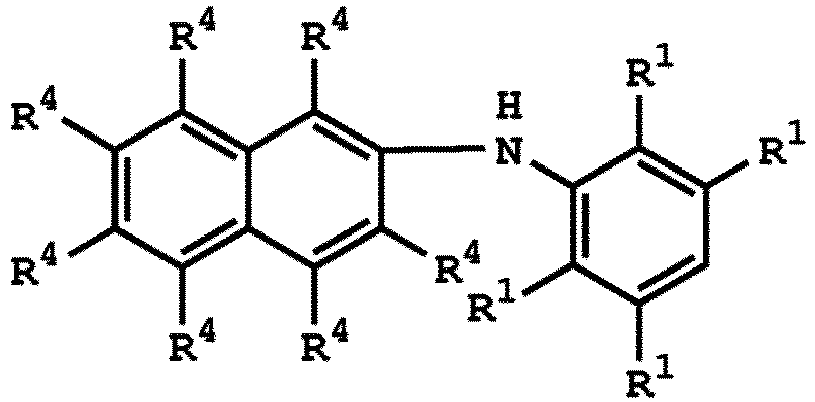
ist, wobei die Verbindung mit der Struktur von Formel (IV)
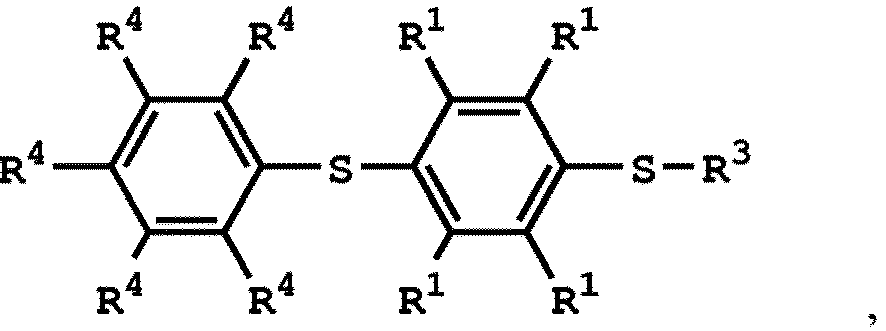


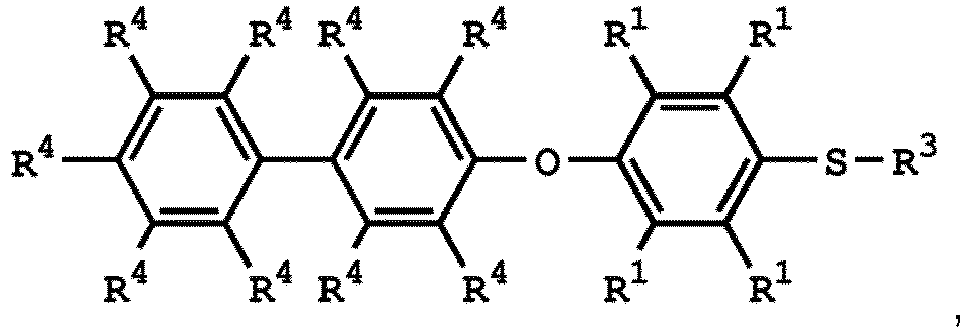
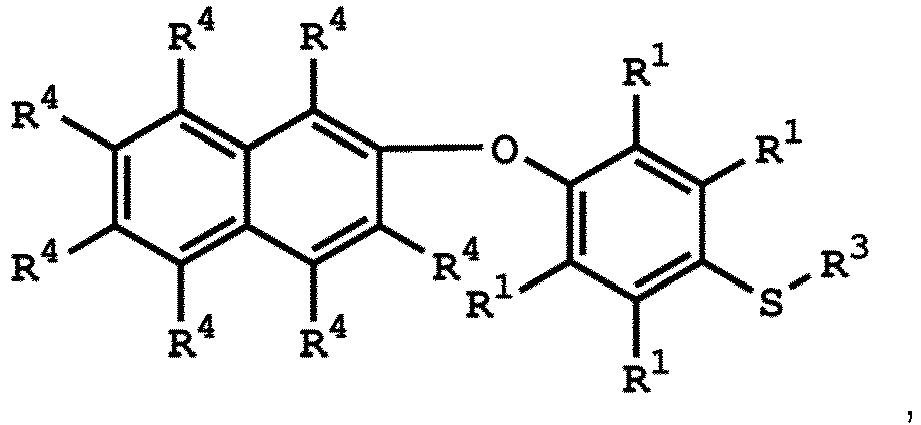


oder

ist, wobei R1 unabhängig Wasserstoff oder eine C1-6-Alkylgruppe ist; R4 unabhängig Wasserstoff oder eine C1-6-Alkylgruppe ist; und R3 unabhängig eine C1-6-Alkylgruppe, eine C5-8-Cycloalkylgruppe oder eine C2-6-Alkoxyalkylgruppe ist, wobei die Verbindung mit der Struktur von Formel (II) Schwefelsäure, Methansulfonsäure, Benzolsulfonsäure, p-Toluolsulfonsäure oder eine Kombination davon ist.
oder
ist, wobei die Verbindung mit der Struktur von Formel (IV)
oder
ist, wobei R1 unabhängig Wasserstoff oder eine C1-6-Alkylgruppe ist; R4 unabhängig Wasserstoff oder eine C1-6-Alkylgruppe ist; und R3 unabhängig eine C1-6-Alkylgruppe, eine C5-8-Cycloalkylgruppe oder eine C2-6-Alkoxyalkylgruppe ist, wobei die Verbindung mit der Struktur von Formel (II) Schwefelsäure, Methansulfonsäure, Benzolsulfonsäure, p-Toluolsulfonsäure oder eine Kombination davon ist.
4. Verfahren nach einem der Ansprüche 1 bis 3, ferner mit dem Schritt:
Umsetzen der Verbindung mit der durch Formel (IV) dargestellten Struktur mit einer Verbindung (A) und Erhalten einer Verbindung mit der durch Formel (V) dargestellten Struktur
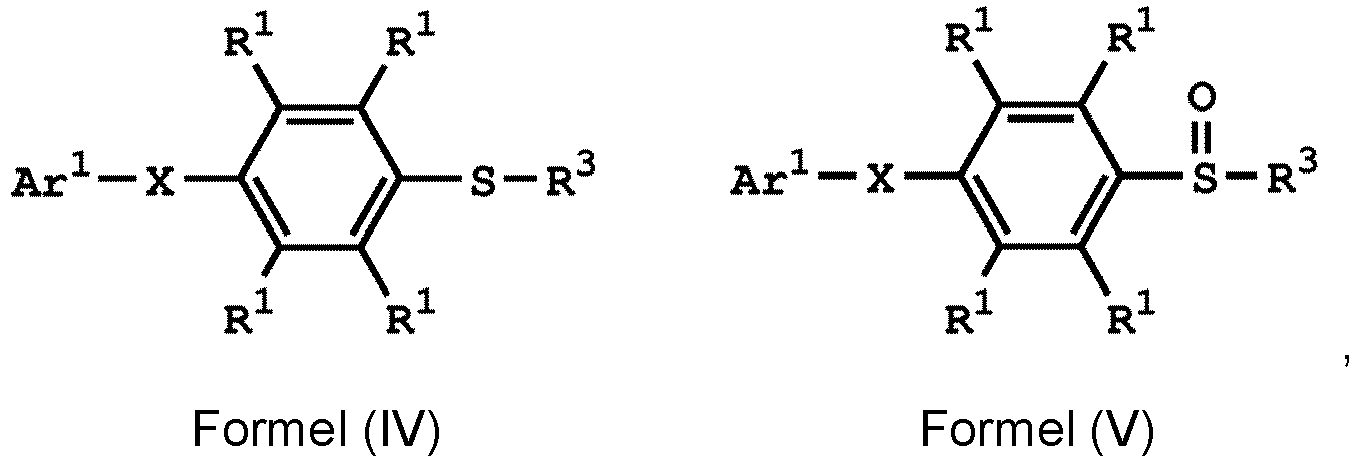
wobei die Verbindung (A) Salpetersäure, Schwefelsäure, Essigsäure, Wasserstoffperoxid oder eine Kombination davon ist; Ar1 substituiert oder unsubstituiert ist; X -O-, -S- oder -NH- ist; R1 unabhängig Wasserstoff oder eine C1-6-Alkylgruppe ist; und R3 unabhängig eine C1-6-Alkylgruppe, eine C5-8-Cycloalkylgruppe oder eine C2-6-Alkoxyalkylgruppe ist.
Umsetzen der Verbindung mit der durch Formel (IV) dargestellten Struktur mit einer Verbindung (A) und Erhalten einer Verbindung mit der durch Formel (V) dargestellten Struktur
wobei die Verbindung (A) Salpetersäure, Schwefelsäure, Essigsäure, Wasserstoffperoxid oder eine Kombination davon ist; Ar1 substituiert oder unsubstituiert ist; X -O-, -S- oder -NH- ist; R1 unabhängig Wasserstoff oder eine C1-6-Alkylgruppe ist; und R3 unabhängig eine C1-6-Alkylgruppe, eine C5-8-Cycloalkylgruppe oder eine C2-6-Alkoxyalkylgruppe ist.
5. Verfahren nach Anspruch 4, wobei die Verbindung mit der Struktur von Formel

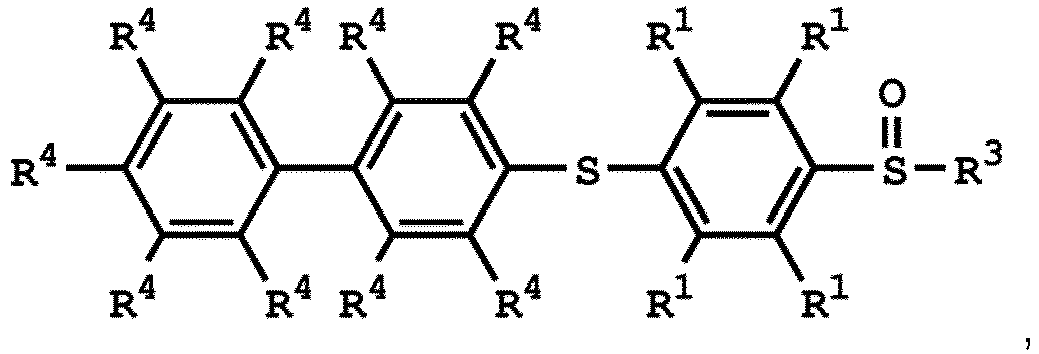




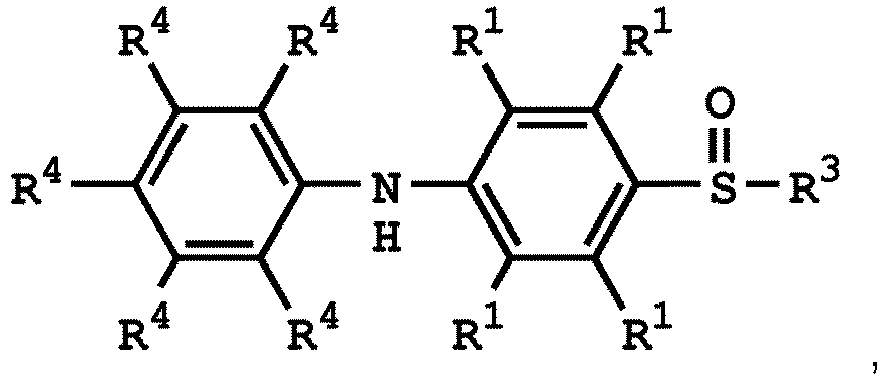

oder

ist, wobei R1 unabhängig Wasserstoff oder eine C1-6-Alkylgruppe ist; R4 unabhängig Wasserstoff oder eine C1-6-Alkylgruppe ist; und R3 unabhängig eine C1-6-Alkylgruppe, eine C5-8-Cycloalkylgruppe oder eine C2-6-Alkoxyalkylgruppe ist.
oder
ist, wobei R1 unabhängig Wasserstoff oder eine C1-6-Alkylgruppe ist; R4 unabhängig Wasserstoff oder eine C1-6-Alkylgruppe ist; und R3 unabhängig eine C1-6-Alkylgruppe, eine C5-8-Cycloalkylgruppe oder eine C2-6-Alkoxyalkylgruppe ist.
6. Verfahren nach Anspruch 4 oder 5, ferner mit dem Schritt:
Umsetzen der Verbindung mit der durch Formel (V) dargestellten Struktur mit einer Verbindung mit einer durch Formel (VI) dargestellten Struktur und Erhalten eines Polymers mit einer durch Formel (VII) dargestellten Wiederholungseinheit
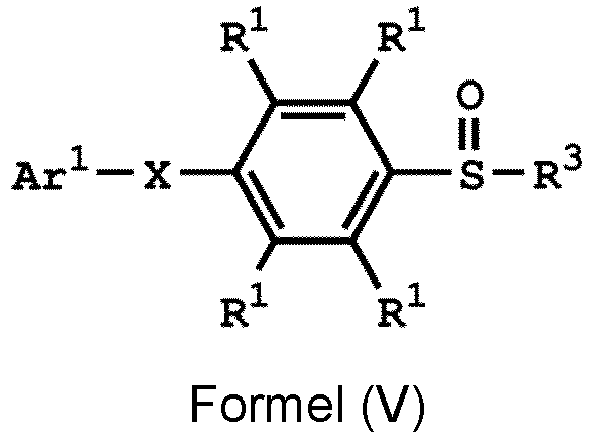

wobei Ar1 eine substituierte oder unsubstituierte Arylgruppe ist; X -O-, - S- oder -NH- ist; R1 unabhängig Wasserstoff oder eine C1-6-Alkylgruppe ist; R3 unabhängig eine C1-6-Alkylgruppe, eine C5-8-Cycloalkylgruppe oder eine C2-6-Alkoxyalkylgruppe ist; R5 eine Hydroxylgruppe, eine C1-6-Alkylgruppe, eine Phenylgruppe oder eine Tolylgruppe ist; und Ar2 ein substituiertes oder unsubstituiertes Aryldiradikal ist.
Umsetzen der Verbindung mit der durch Formel (V) dargestellten Struktur mit einer Verbindung mit einer durch Formel (VI) dargestellten Struktur und Erhalten eines Polymers mit einer durch Formel (VII) dargestellten Wiederholungseinheit
wobei Ar1 eine substituierte oder unsubstituierte Arylgruppe ist; X -O-, - S- oder -NH- ist; R1 unabhängig Wasserstoff oder eine C1-6-Alkylgruppe ist; R3 unabhängig eine C1-6-Alkylgruppe, eine C5-8-Cycloalkylgruppe oder eine C2-6-Alkoxyalkylgruppe ist; R5 eine Hydroxylgruppe, eine C1-6-Alkylgruppe, eine Phenylgruppe oder eine Tolylgruppe ist; und Ar2 ein substituiertes oder unsubstituiertes Aryldiradikal ist.
7. Verfahren nach Anspruch 6, wobei die Verbindung mit der Struktur von Formel (VI) Schwefelsäure,
Methansulfonsäure, Benzolsulfonsäure, p-Toluolsulfonsäure oder eine Kombination davon
ist.
8. Verfahren nach Anspruch 6 oder 7, wobei Ar2 eine substituierte oder unsubstituierte Phenylengruppe, Biphenylengruppe, Naphthylengruppe,
Thienylengruppe, Indolylengruppe, Phenanthrenylengruppe, Indenylengruppe, Anthracenylengruppe
oder Fluorenylengruppe ist.
9. Verfahren nach einem der Ansprüche 6 bis 8, ferner mit dem Schritt:
Umsetzen eines Nucleophils mit dem Polymer mit der durch Formel (VII) dargestellten Wiederholungseinheit und Erhalten eines Polymers mit einer durch Formel (VIII) dargestellten Wiederholungseinheit

wobei X -O-, -S- oder -NH- ist; R1 unabhängig Wasserstoff oder eine C1-6-Alkylgruppe ist; R3 unabhängig eine C1-6-Alkylgruppe, eine C5-8-Cycloalkylgruppe oder eine C2-6-Alkoxyalkylgruppe ist; R5 eine Hydroxylgruppe, eine C1-6-Alkylgruppe, eine Phenylgruppe oder eine Tolylgruppe ist; und Ar2 ein substituiertes oder unsubstituiertes Aryldiradikal ist.
Umsetzen eines Nucleophils mit dem Polymer mit der durch Formel (VII) dargestellten Wiederholungseinheit und Erhalten eines Polymers mit einer durch Formel (VIII) dargestellten Wiederholungseinheit
wobei X -O-, -S- oder -NH- ist; R1 unabhängig Wasserstoff oder eine C1-6-Alkylgruppe ist; R3 unabhängig eine C1-6-Alkylgruppe, eine C5-8-Cycloalkylgruppe oder eine C2-6-Alkoxyalkylgruppe ist; R5 eine Hydroxylgruppe, eine C1-6-Alkylgruppe, eine Phenylgruppe oder eine Tolylgruppe ist; und Ar2 ein substituiertes oder unsubstituiertes Aryldiradikal ist.
10. Verfahren nach Anspruch 9, wobei das Nucleophil Pyridin, 4-Methylpyridin, Triethylamin,
Kaliumchlorid, Methanol, Ethanol, Dimethylformamid, Dimethylacetamid, N-Methylpyrrolidon
oder eine Kombination davon ist.
11. Verfahren nach Anspruch 9 oder 10, ferner mit dem Schritt, wenn X des Polymers mit
der durch Formel (VIII) dargestellten Wiederholungseinheit -O- oder - NH- ist:
Umsetzen des Polymers mit der durch Formel (VIII) dargestellten Wiederholungseinheit mit Wasserstoffperoxid und Erhalten eines Polymers mit einer durch Formel (X) dargestellten Wiederholungseinheit
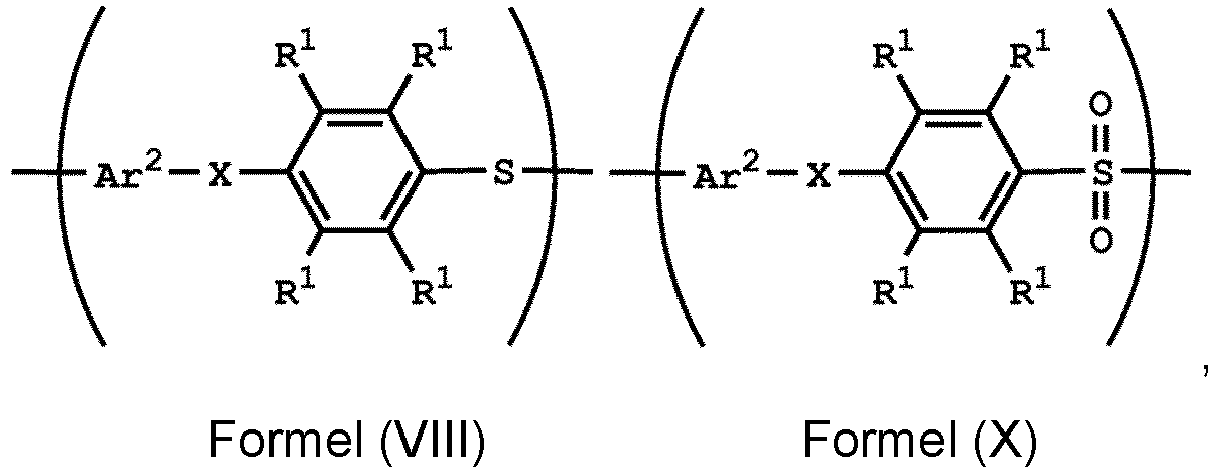
wobei X -O- oder -NH- ist; R1 unabhängig Wasserstoff oder eine C1-6-Alkylgruppe ist; und Ar2 ein substituiertes oder unsubstituiertes Aryldiradikal ist.
Umsetzen des Polymers mit der durch Formel (VIII) dargestellten Wiederholungseinheit mit Wasserstoffperoxid und Erhalten eines Polymers mit einer durch Formel (X) dargestellten Wiederholungseinheit
wobei X -O- oder -NH- ist; R1 unabhängig Wasserstoff oder eine C1-6-Alkylgruppe ist; und Ar2 ein substituiertes oder unsubstituiertes Aryldiradikal ist.
12. Verfahren nach Anspruch 11, wobei ein Polymer mit der durch Formel (VIII) dargestellten
Wiederholungseinheit mit Wasserstoffperoxid in Gegenwart einer Verbindung mit einer
durch Formel (IX) dargestellten Struktur umgesetzt wird.
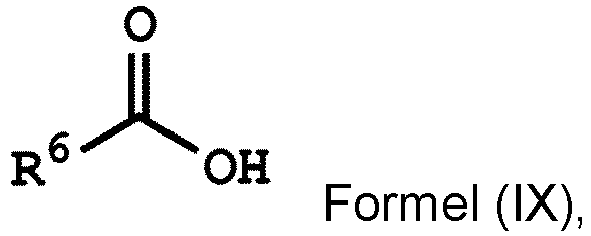
wobei R6 eine C1-6-Alkylgruppe ist.
wobei R6 eine C1-6-Alkylgruppe ist.
13. Verfahren nach einem der Ansprüche 6 bis 8, ferner mit dem Schritt, wenn X des Polymers
mit der durch die Formel (VII) dargestellten Wiederholungseinheit -S- ist:
Umsetzen des Polymers mit der durch Formel (VII) dargestellten Wiederholungseinheit mit Wasserstoffperoxid und Erhalten eines Polymers mit einer durch Formel (XI) dargestellten Wiederholungseinheit


wobei X -S- ist; R1 unabhängig Wasserstoff oder eine C1-6-Alkylgruppe ist; R3 unabhängig eine C1-6-Alkylgruppe, eine C5-8-CyCloalkylgruppe oder eine C2-6-Alkoxyalkylgruppe ist; R5 eine Hydroxylgruppe, eine C1-6-Alkylgruppe, eine Phenylgruppe oder eine Tolylgruppe ist; und Ar2 ein substituiertes oder unsubstituiertes Aryldiradikal ist.
Umsetzen des Polymers mit der durch Formel (VII) dargestellten Wiederholungseinheit mit Wasserstoffperoxid und Erhalten eines Polymers mit einer durch Formel (XI) dargestellten Wiederholungseinheit
wobei X -S- ist; R1 unabhängig Wasserstoff oder eine C1-6-Alkylgruppe ist; R3 unabhängig eine C1-6-Alkylgruppe, eine C5-8-CyCloalkylgruppe oder eine C2-6-Alkoxyalkylgruppe ist; R5 eine Hydroxylgruppe, eine C1-6-Alkylgruppe, eine Phenylgruppe oder eine Tolylgruppe ist; und Ar2 ein substituiertes oder unsubstituiertes Aryldiradikal ist.
14. Verfahren nach Anspruch 13, wobei das Polymer mit der durch die Formel (VII) dargestellten
Wiederholungseinheit mit Wasserstoffperoxid in Gegenwart einer Verbindung mit einer
durch die Formel (IX) dargestellten Struktur umgesetzt wird
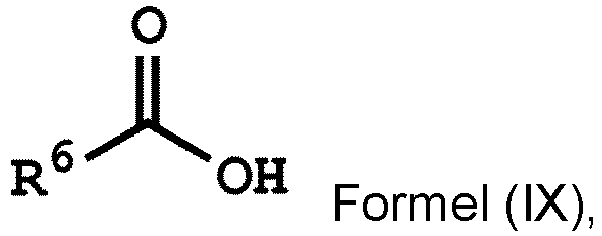
wobei R6 eine C1-6-Alkylgruppe ist.
wobei R6 eine C1-6-Alkylgruppe ist.
15. Verfahren nach Anspruch 13 oder 14, ferner mit dem Schritt:
Umsetzen eines Nucleophils mit dem Polymer mit der durch Formel (XI) dargestellten Wiederholungseinheit und Erhalten eines Polymers mit einer durch Formel (XII) dargestellten Wiederholungseinheit

wobei R1 unabhängig Wasserstoff oder eine C1-6-Alkylgruppe ist; R3 unabhängig eine C1-6-Alkylgruppe, eine C5-8-Cycloalkylgruppe oder eine C2-6-Alkoxyalkylgruppe ist; R5 eine Hydroxylgruppe, eine C1-6-Alkylgruppe, eine Phenylgruppe oder eine Tolylgruppe ist; und Ar2 ein substituiertes oder unsubstituiertes Aryldiradikal ist, wobei das Nucleophil Pyridin, 4-Methylpyridin, Triethylamin, Kaliumchlorid, Methanol, Ethanol, Dimethylformamid, Dimethylacetamid, N-Methylpyrrolidon oder eine Kombination davon ist.
Umsetzen eines Nucleophils mit dem Polymer mit der durch Formel (XI) dargestellten Wiederholungseinheit und Erhalten eines Polymers mit einer durch Formel (XII) dargestellten Wiederholungseinheit
wobei R1 unabhängig Wasserstoff oder eine C1-6-Alkylgruppe ist; R3 unabhängig eine C1-6-Alkylgruppe, eine C5-8-Cycloalkylgruppe oder eine C2-6-Alkoxyalkylgruppe ist; R5 eine Hydroxylgruppe, eine C1-6-Alkylgruppe, eine Phenylgruppe oder eine Tolylgruppe ist; und Ar2 ein substituiertes oder unsubstituiertes Aryldiradikal ist, wobei das Nucleophil Pyridin, 4-Methylpyridin, Triethylamin, Kaliumchlorid, Methanol, Ethanol, Dimethylformamid, Dimethylacetamid, N-Methylpyrrolidon oder eine Kombination davon ist.
1. Procédé de préparation d'un composé comprenant :
la réaction d'un composé ayant une structure représentée par la formule (I) avec un composé ayant une structure représentée par la formule (III) en présence d'un composé ayant une structure représentée par la formule (II), en obtenant un composé ayant une structure représentée par la formule (IV)


où Ar1 est un groupe aryle substitué ou non substitué ; X est un groupe -O-, -S- ou -NH- ; R1 est de manière indépendante un atome d'hydrogène ou un groupe alkyle en C1 à 6 ; R2 est un groupe hydroxyle, un groupe alkyle en C1 à 6, un groupe phényle ou un groupe tolyle ; et R3 est de manière indépendante un groupe alkyle en C1 à 6, un groupe cycloalkyle en C5 à 8 ou un groupe alcoxy alkyle en C2 à 6.
la réaction d'un composé ayant une structure représentée par la formule (I) avec un composé ayant une structure représentée par la formule (III) en présence d'un composé ayant une structure représentée par la formule (II), en obtenant un composé ayant une structure représentée par la formule (IV)
où Ar1 est un groupe aryle substitué ou non substitué ; X est un groupe -O-, -S- ou -NH- ; R1 est de manière indépendante un atome d'hydrogène ou un groupe alkyle en C1 à 6 ; R2 est un groupe hydroxyle, un groupe alkyle en C1 à 6, un groupe phényle ou un groupe tolyle ; et R3 est de manière indépendante un groupe alkyle en C1 à 6, un groupe cycloalkyle en C5 à 8 ou un groupe alcoxy alkyle en C2 à 6.
2. Procédé selon la revendication 1, dans lequel Ar1 est un groupe phényle substitué ou non substitué, un groupe biphényle, un groupe
naphtyle, une groupe thiényle, un groupe indolyle, un groupe phénanthrényle, un groupe
indényle, un groupe anthracényle ou un groupe fluorénylène, où R1 est de manière indépendante un atome d'hydrogène, un groupe méthyle, un groupe éthyle,
un groupe propyle, un groupe isopropyle, un groupe n-butyle, un groupe t-butyle, un
groupe butyle secondaire, un groupe isobutyle, un groupe pentyle ou un groupe hexyle,
où R3 est de manière indépendante un groupe méthyle, un groupe éthyle, un groupe propyle,
un groupe isopropyle, un groupe n-butyle, un groupe t-butyle, un groupe butyle secondaire,
un groupe isobutyle, un groupe pentyle, un groupe hexyle, un groupe cyclopentyle,
un groupe cyclohexyle, un groupe cycloheptyle, un groupe cyclooctyle, ou un groupe
-(CH2)n-O-(CH2)m-CH3, où 1 ≤ n ≤ 5, 0 ≤ m ≤ 4, et 1 ≤ n +m ≤ 5.
3. Procédé selon la revendication 1, dans lequel le composé ayant la structure selon
la formule (I) est





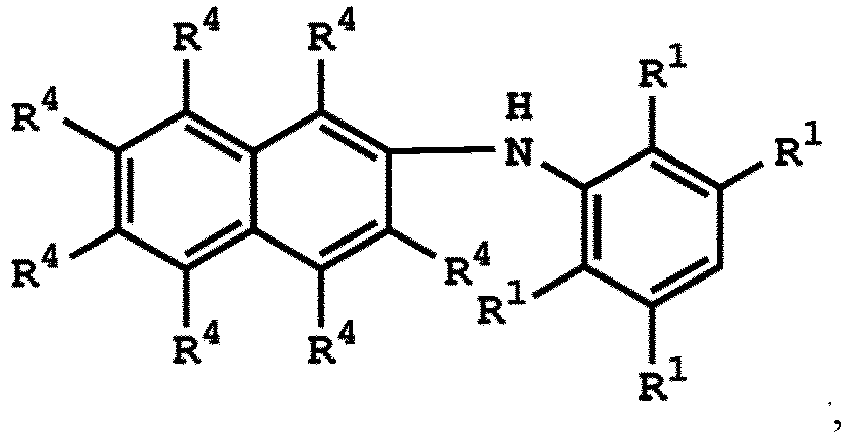
où le composé ayant la structure selon la formule (IV) est




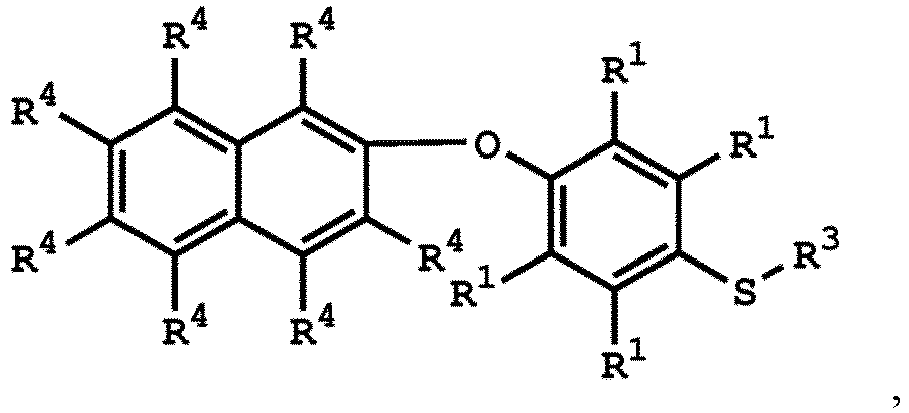


ou

où R1 est de manière indépendante un atome d'hydrogène ou un groupe alkyle en C1 à 6 ; R4 est de manière indépendante un atome d'hydrogène ou un groupe alkyle en C1 à 6 ; et R3 est de manière indépendante un groupe alkyle en C1 à 6, un groupe cycloalkyle en C5 à 8 ou un groupe alcoxy alkyle en C2 à 6, où le composé ayant la structure selon la formule (II) est de l'acide sulfurique de l'acide méthane sulfonique, de l'acide benzène sulfonique, de l'acide p-toluène sulfonique, ou une combinaison de ceux-ci.
où le composé ayant la structure selon la formule (IV) est
ou
où R1 est de manière indépendante un atome d'hydrogène ou un groupe alkyle en C1 à 6 ; R4 est de manière indépendante un atome d'hydrogène ou un groupe alkyle en C1 à 6 ; et R3 est de manière indépendante un groupe alkyle en C1 à 6, un groupe cycloalkyle en C5 à 8 ou un groupe alcoxy alkyle en C2 à 6, où le composé ayant la structure selon la formule (II) est de l'acide sulfurique de l'acide méthane sulfonique, de l'acide benzène sulfonique, de l'acide p-toluène sulfonique, ou une combinaison de ceux-ci.
4. Procédé selon l'une quelconque des revendications 1 à 3, comprenant en outre :
la réaction du composé ayant la structure représentée par la formule (IV) avec un composé (A), en obtenant un composé ayant la structure représentée par la formule (V)
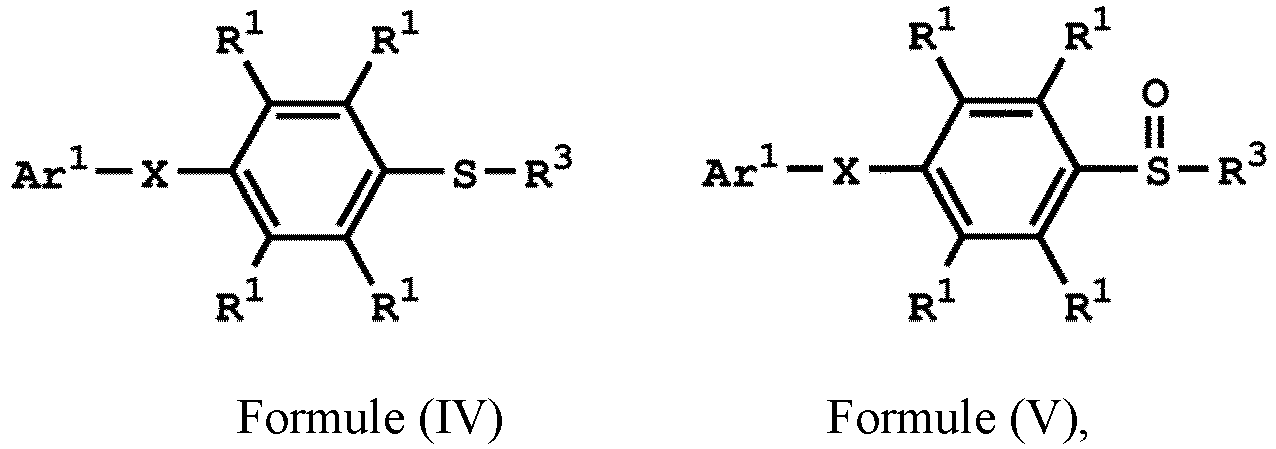
où le composé (A) est de l'acide nitrique, de l'acide sulfurique, de l'acide acétique, du peroxyde d'hydrogène, ou une combinaison de ceux-ci, Ar1 est substitué ou non substitué ; X est un groupe -O-, -S- ou -NH- ; R1 est de manière indépendante un atome d'hydrogène ou un groupe alkyle en C1 à 6 ; et R3 est de manière indépendante un groupe alkyle en C1 à 6, un groupe cycloalkyle en C5 à 8 ou un groupe alcoxy alkyle en C2 à 6.
la réaction du composé ayant la structure représentée par la formule (IV) avec un composé (A), en obtenant un composé ayant la structure représentée par la formule (V)
où le composé (A) est de l'acide nitrique, de l'acide sulfurique, de l'acide acétique, du peroxyde d'hydrogène, ou une combinaison de ceux-ci, Ar1 est substitué ou non substitué ; X est un groupe -O-, -S- ou -NH- ; R1 est de manière indépendante un atome d'hydrogène ou un groupe alkyle en C1 à 6 ; et R3 est de manière indépendante un groupe alkyle en C1 à 6, un groupe cycloalkyle en C5 à 8 ou un groupe alcoxy alkyle en C2 à 6.
5. Procédé selon la revendication 4, dans lequel le composé ayant la structure selon
la formule (V) est



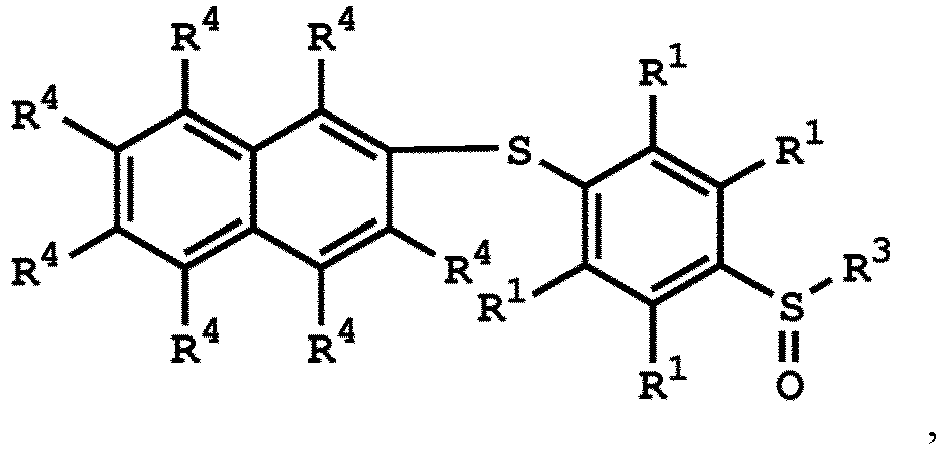




ou

où R1 est de manière indépendante un atome d'hydrogène ou un groupe alkyle en C1 à 6 ; R4 est de manière indépendante un atome d'hydrogène ou un groupe alkyle en C1 à 6 ; et R3 est de manière indépendante un groupe alkyle en C1 à 6, un groupe cycloalkyle en C5 à 8 ou un groupe alcoxy alkyle en C2 à 6.
ou
où R1 est de manière indépendante un atome d'hydrogène ou un groupe alkyle en C1 à 6 ; R4 est de manière indépendante un atome d'hydrogène ou un groupe alkyle en C1 à 6 ; et R3 est de manière indépendante un groupe alkyle en C1 à 6, un groupe cycloalkyle en C5 à 8 ou un groupe alcoxy alkyle en C2 à 6.
6. Procédé selon l'une quelconque des revendications 4 et 5, comprenant en outre :
la réaction du composé ayant la structure représentée par la formule (V) avec un composé ayant une structure représentée par la formule (VI), en obtenant un polymère ayant une unité de répétition représentée par la formule (VII)


où Ar1 est un groupe aryle substitué ou non substitué ; X est un groupe -O-, -S- ou -NH- ; R1 est de manière indépendante un atome d'hydrogène ou un groupe alkyle en C1 à 6 ; R3 est de manière indépendante un groupe alkyle en C1 à 6, un groupe cycloalkyle en C5 à 8 ou un groupe alcoxy alkyle en C2 à 6 ; R5 est un groupe hydroxyle, un groupe alkyle en C1 à 6, un groupe phényle ou un groupe tolyle ; et Ar2 est un diradical aryle substitué ou non substitué.
la réaction du composé ayant la structure représentée par la formule (V) avec un composé ayant une structure représentée par la formule (VI), en obtenant un polymère ayant une unité de répétition représentée par la formule (VII)
où Ar1 est un groupe aryle substitué ou non substitué ; X est un groupe -O-, -S- ou -NH- ; R1 est de manière indépendante un atome d'hydrogène ou un groupe alkyle en C1 à 6 ; R3 est de manière indépendante un groupe alkyle en C1 à 6, un groupe cycloalkyle en C5 à 8 ou un groupe alcoxy alkyle en C2 à 6 ; R5 est un groupe hydroxyle, un groupe alkyle en C1 à 6, un groupe phényle ou un groupe tolyle ; et Ar2 est un diradical aryle substitué ou non substitué.
7. Procédé selon la revendication 6, dans lequel le composé ayant la structure selon
la formule (VI) est de l'acide sulfurique, de l'acide méthane sulfurique, de l'acide
benzène sulfonique, de l'acide p-toluène sulfonique ou une combinaison de ceux-ci.
8. Procédé selon l'une quelconque des revendications 6 et 7, dans lequel Ar2 est un groupe phénylène substitué ou non substitué, un groupe biphénylène, un groupe
naphtylène, un groupe thiénylène, un groupe indolylène, un groupe phénanthrénylène,
un groupe indénylène, un groupe anthracénylène ou un groupe fluorénylène.
9. Procédé selon l'une quelconque des revendications 6 à 8, comprenant en outre :
la réaction d'un nucléophile avec le polymère ayant l'unité de répétition représentée par la formule (VII), en obtenant un polymère ayant une unité de répétition représentée par la formule (VIII)
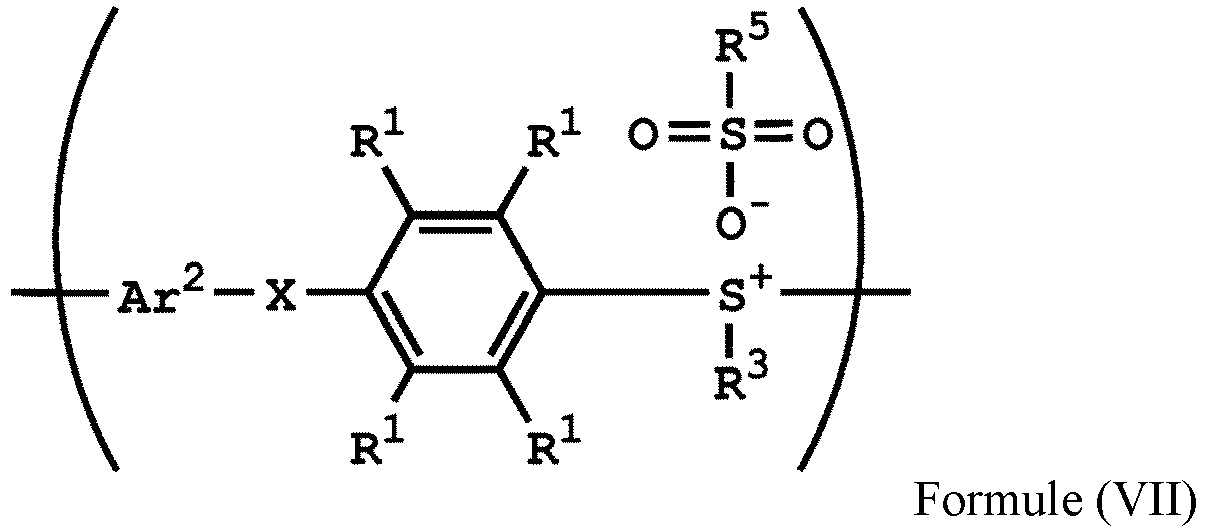

où X est de manière indépendante un groupe -O-, -S- ou -NH- ; R1 est de manière indépendante un atome d'hydrogène ou un groupe alkyle en C1 à 6 ; R3 est de manière indépendante un groupe alkyle en C1 à 6, un groupe cycloalkyle en C5 à 8 ou un groupe alcoxy alkyle en C2 à 6 ; R5 est un groupe hydroxyle, un groupe alkyle en C1 à 6, un groupe phényle ou un groupe tolyle ; et Ar2 est un diradical aryle substitué ou non substitué.
la réaction d'un nucléophile avec le polymère ayant l'unité de répétition représentée par la formule (VII), en obtenant un polymère ayant une unité de répétition représentée par la formule (VIII)
où X est de manière indépendante un groupe -O-, -S- ou -NH- ; R1 est de manière indépendante un atome d'hydrogène ou un groupe alkyle en C1 à 6 ; R3 est de manière indépendante un groupe alkyle en C1 à 6, un groupe cycloalkyle en C5 à 8 ou un groupe alcoxy alkyle en C2 à 6 ; R5 est un groupe hydroxyle, un groupe alkyle en C1 à 6, un groupe phényle ou un groupe tolyle ; et Ar2 est un diradical aryle substitué ou non substitué.
10. Procédé selon la revendication 9, dans lequel le nucléophile est la pyridine, la 4-méthyl
pyridine, la triéthylamine, le chlorure de potassium, le méthanol, l'éthanol, le diméthyl
formamide, le diméthyl acétamide, la n-méthyl pyrrolidone, ou une combinaison de ceux-ci.
11. Procédé selon l'une quelconque des revendications 9 et 10, lorsque X du polymère possédant
l'unité de répétition représentée par la formule (VIII) est -O- ou -NH-, comprenant
en outre :
la réaction du polymère possédant l'unité de répétition représentée par la formule (VIII) avec du peroxyde d'hydrogène, en obtenant un polymère ayant une unité de répétition représentée par la formule (X)

où X est un groupe -O- ou -NH- ; R1 est de manière indépendante un atome d'hydrogène ou un groupe alkyle en C1 à 6 ; et Ar2 est un diradical aryle substitué ou non substitué.
la réaction du polymère possédant l'unité de répétition représentée par la formule (VIII) avec du peroxyde d'hydrogène, en obtenant un polymère ayant une unité de répétition représentée par la formule (X)
où X est un groupe -O- ou -NH- ; R1 est de manière indépendante un atome d'hydrogène ou un groupe alkyle en C1 à 6 ; et Ar2 est un diradical aryle substitué ou non substitué.
12. Procédé selon la revendication 11, dans lequel un polymère possédant l'unité de répétition
représentée par la formule (VIII) est mis à réagir avec du peroxyde d'hydrogène en
présence d'un composé ayant une structure représentée par la formule (IX)

où R6 est un groupe alkyle en C1 à 6.
où R6 est un groupe alkyle en C1 à 6.
13. Procédé selon l'une quelconque des revendications 6 à 8, lorsque X du polymère possédant
l'unité de répétition représentée par la formule (VII) est -S-, comprenant en outre
:
la réaction du polymère possédant l'unité de répétition représentée par la formule (VII) avec du peroxyde d'hydrogène, en obtenant un polymère ayant une unité de répétition représentée par la formule (XI)

où X est -S- ; R1 est de manière indépendante un atome d'hydrogène ou un groupe alkyle en C1 à 6 ; R3 est de manière indépendante un groupe alkyle en C1 à 6, un groupe cycloalkyle en C5 à 8 ou un groupe alcoxy alkyle en C2 à 6 ; R5 est un groupe hydroxyle, un groupe alkyle en C1 à 6, un groupe phényle ou un groupe tolyle ; et Ar2 est un diradical aryle substitué ou non substitué.
la réaction du polymère possédant l'unité de répétition représentée par la formule (VII) avec du peroxyde d'hydrogène, en obtenant un polymère ayant une unité de répétition représentée par la formule (XI)
où X est -S- ; R1 est de manière indépendante un atome d'hydrogène ou un groupe alkyle en C1 à 6 ; R3 est de manière indépendante un groupe alkyle en C1 à 6, un groupe cycloalkyle en C5 à 8 ou un groupe alcoxy alkyle en C2 à 6 ; R5 est un groupe hydroxyle, un groupe alkyle en C1 à 6, un groupe phényle ou un groupe tolyle ; et Ar2 est un diradical aryle substitué ou non substitué.
14. Procédé selon la revendication 13, dans lequel le polymère possédant l'unité de répétition
représentée par la formule (VII) est mis à réagir avec du peroxyde d'hydrogène en
présence d'un composé ayant une structure représentée par la formule (IX)
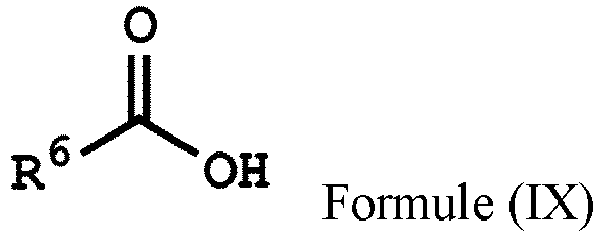
où R6 est un groupe alkyle en C1 à 6.
où R6 est un groupe alkyle en C1 à 6.
15. Procédé selon l'une quelconque des revendications 13 et 14, comprenant en outre :
la réaction d'un nucléophile avec le polymère ayant l'unité de répétition représentée par la formule (XI), en obtenant un polymère ayant une unité de répétition représentée par la formule (XII)
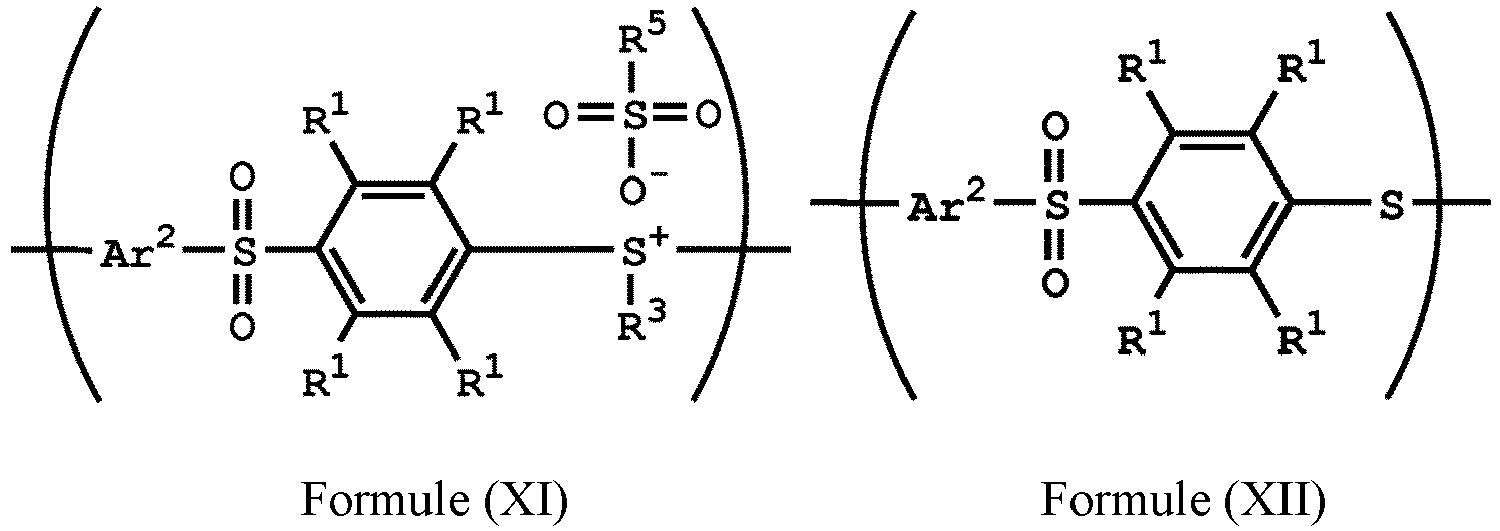
où R1 est de manière indépendante un atome d'hydrogène ou un groupe alkyle en C1 à 6 ; R3 est de manière indépendante un groupe alkyle en C1 à 6, un groupe cycloalkyle en C5 à 8 ou un groupe alcoxy alkyle en C2 à 6 ; R5 est un groupe hydroxyle, un groupe alkyle en C1 à 6, un groupe phényle ou un groupe tolyle ; et Ar2 est un diradical aryle substitué ou non substitué, où le nucléophile est la pyridine, la 4-méthyl pyridine, la triéthylamine, le chlorure de potassium, le méthanol, l'éthanol, le diméthyl formamide, le diméthyl acétamide, la n-méthyl pyrrolidone, ou une combinaison de ceux-ci.
la réaction d'un nucléophile avec le polymère ayant l'unité de répétition représentée par la formule (XI), en obtenant un polymère ayant une unité de répétition représentée par la formule (XII)
où R1 est de manière indépendante un atome d'hydrogène ou un groupe alkyle en C1 à 6 ; R3 est de manière indépendante un groupe alkyle en C1 à 6, un groupe cycloalkyle en C5 à 8 ou un groupe alcoxy alkyle en C2 à 6 ; R5 est un groupe hydroxyle, un groupe alkyle en C1 à 6, un groupe phényle ou un groupe tolyle ; et Ar2 est un diradical aryle substitué ou non substitué, où le nucléophile est la pyridine, la 4-méthyl pyridine, la triéthylamine, le chlorure de potassium, le méthanol, l'éthanol, le diméthyl formamide, le diméthyl acétamide, la n-méthyl pyrrolidone, ou une combinaison de ceux-ci.
REFERENCES CITED IN THE DESCRIPTION
This list of references cited by the applicant is for the reader's convenience only. It does not form part of the European patent document. Even though great care has been taken in compiling the references, errors or omissions cannot be excluded and the EPO disclaims all liability in this regard.
Patent documents cited in the description
Non-patent literature cited in the description
- BERNARD MILLER et al.Reactions of diaryl disulfides with active, nonucleophilic alkylating agentsJournal of Organic Chemistry, 1971, vol. 36, 111513-1519 [0004]
- PIETRO COGOLLI et al.Nucleophilic aromatic substitution reactions of unactivated aryl halides with thiolate ions in hexamethylphosphoramideThe Journal of Organic Chemistry, 1979, vol. 44, 152642-2646 [0005]
- Polymerization of Diphenyl Disulfide by the S-S Bond Cleavage with a Lewis Acid: A Novel Preparation Route to Poly(-phenylene sulfide)EISHUN TSUCHIDA et al.MacromoleculesAm. Chem. Soc.19900416vol. 23, 2101-2106 [0006]
- GABLER R. et al.Neue Polyphenylsulfone Reaktionen an festen PolymerenChimia International Journal for Chemistry, 1974, vol. 28, 567-575 [0007]
- Preparation of Poly(thioarylenes)s from Cyclic Disulfide OligomersDING Y et al.MacromoleculesAm. Chem. Soc.19970505vol. 30, 2527-2531 [0008]
